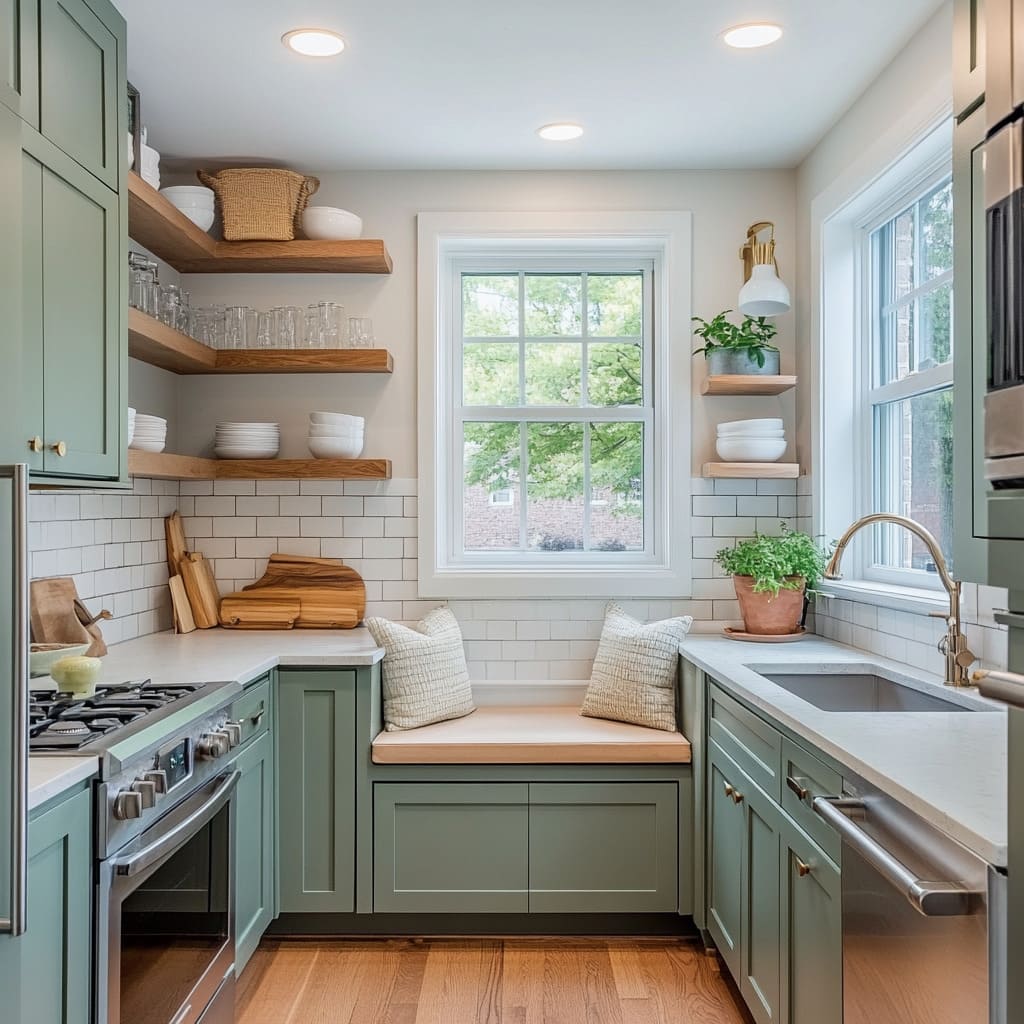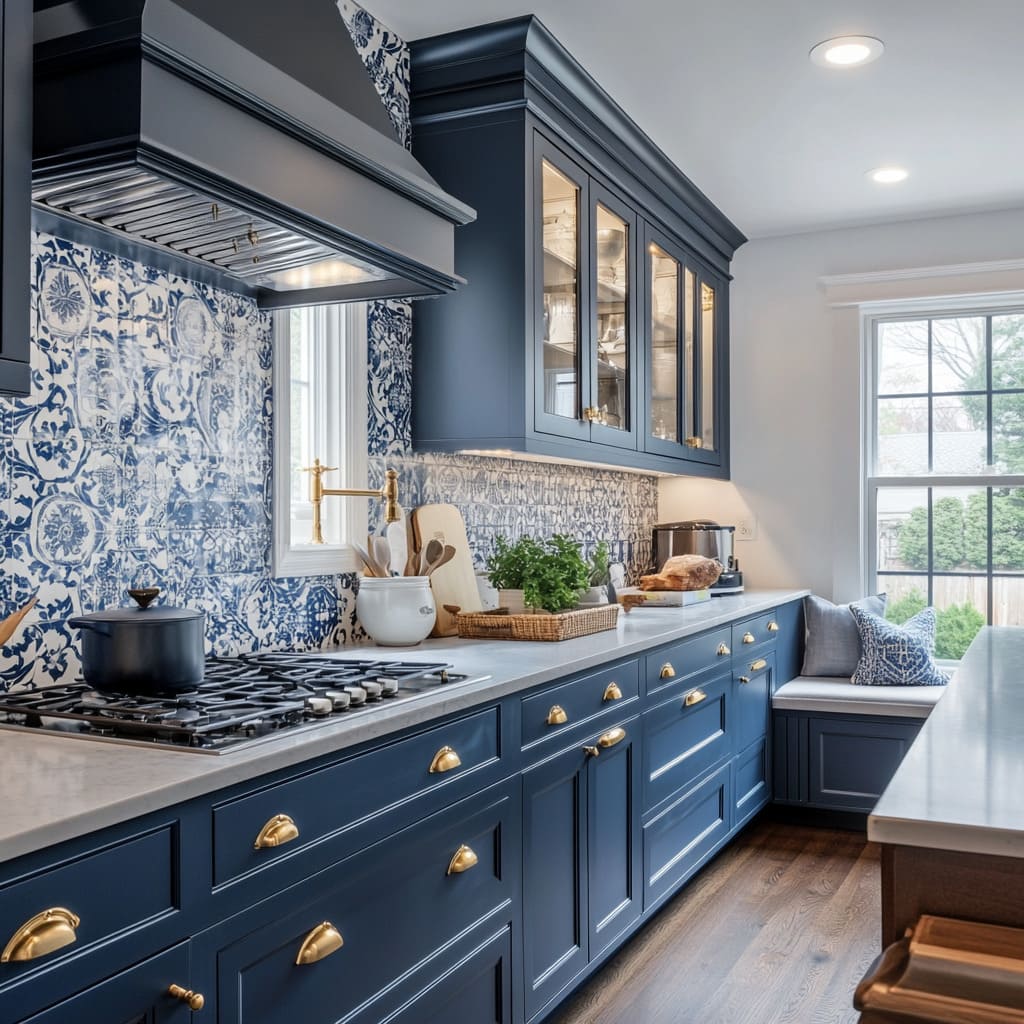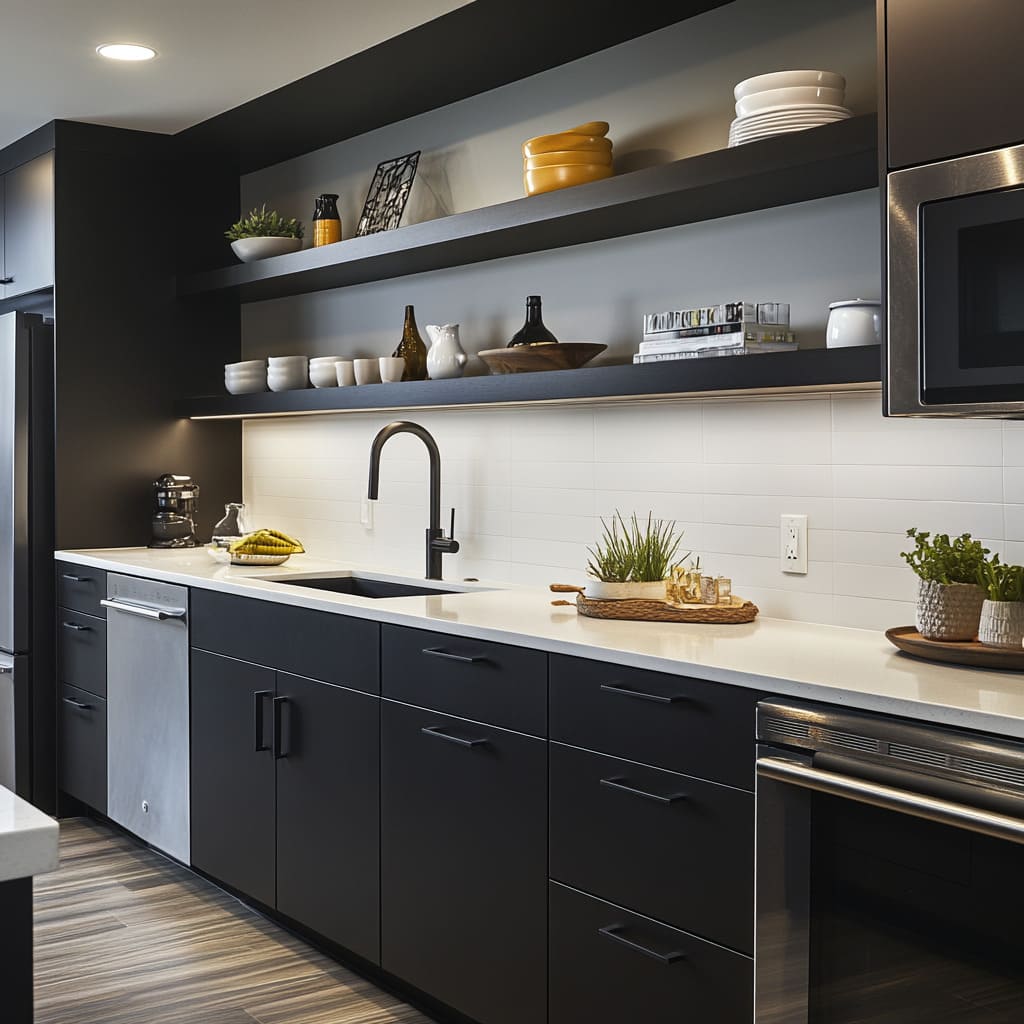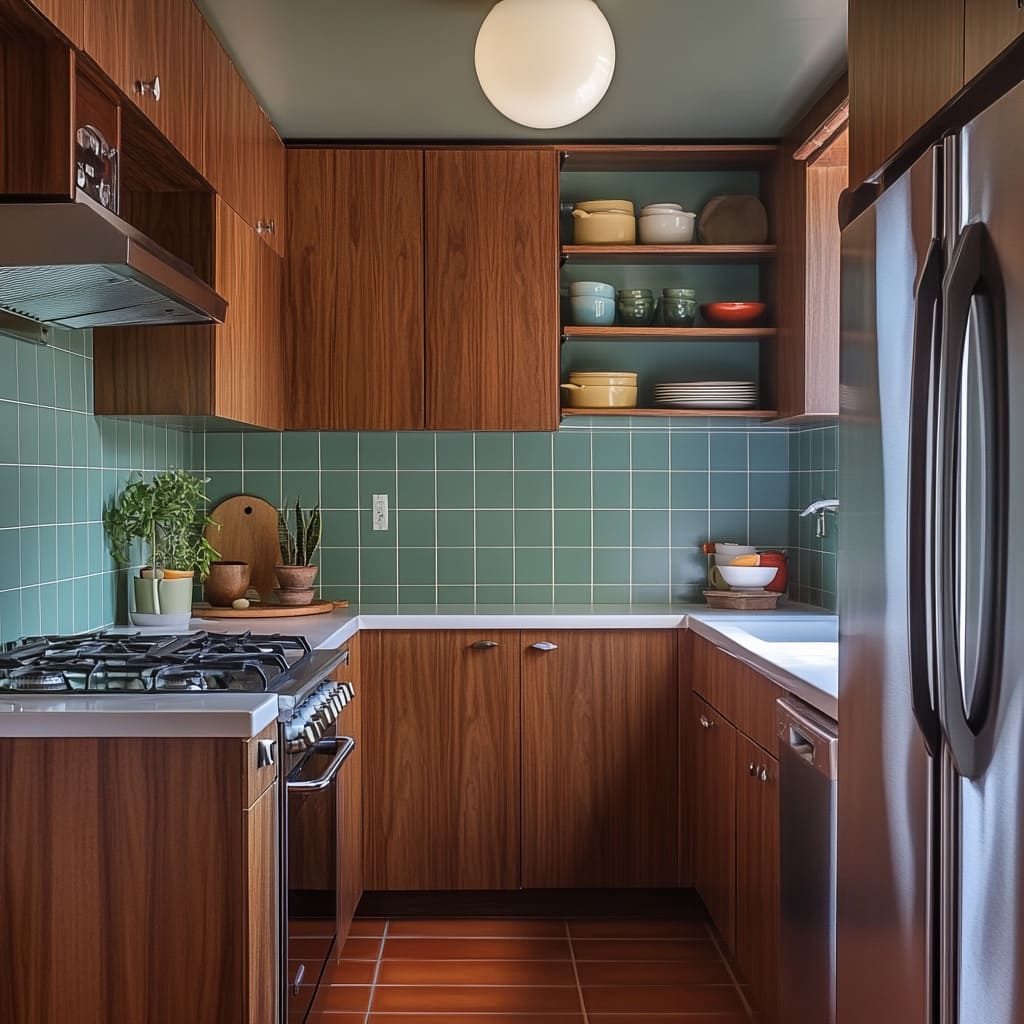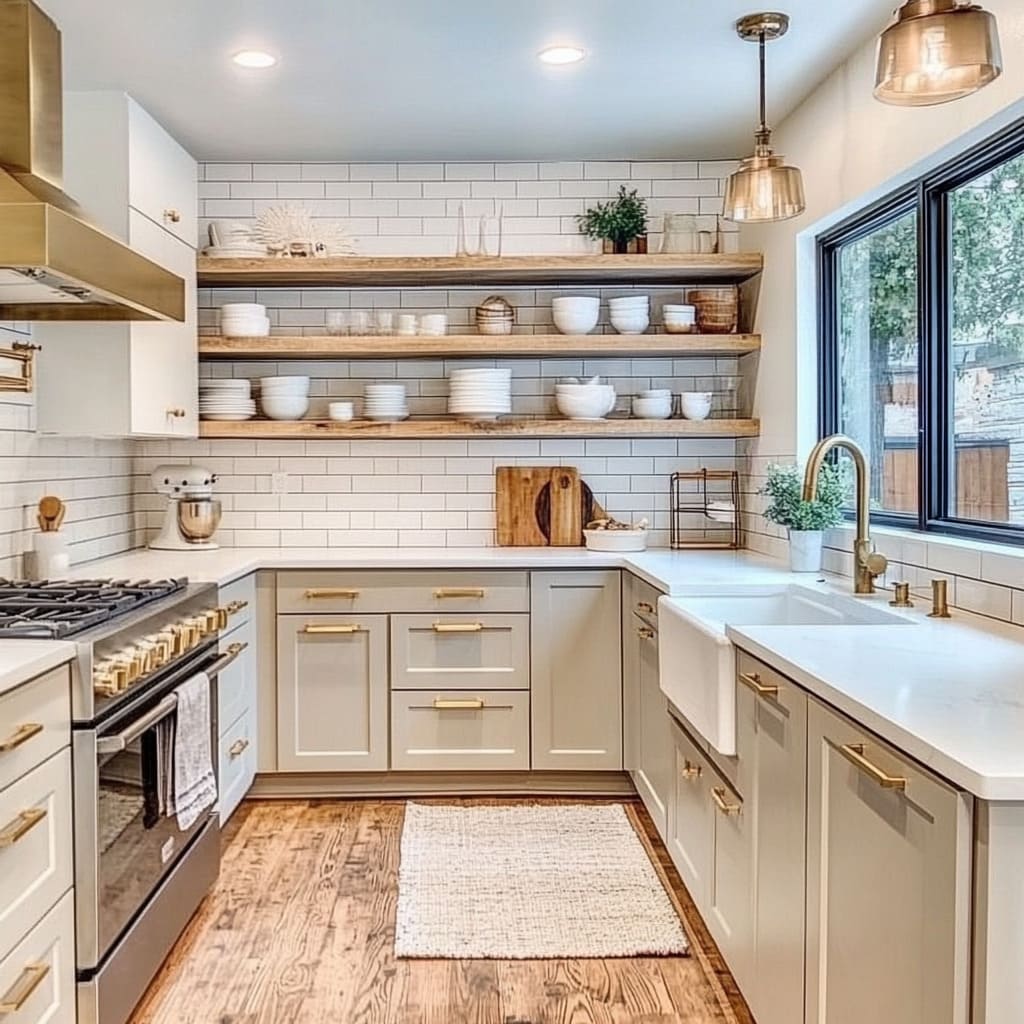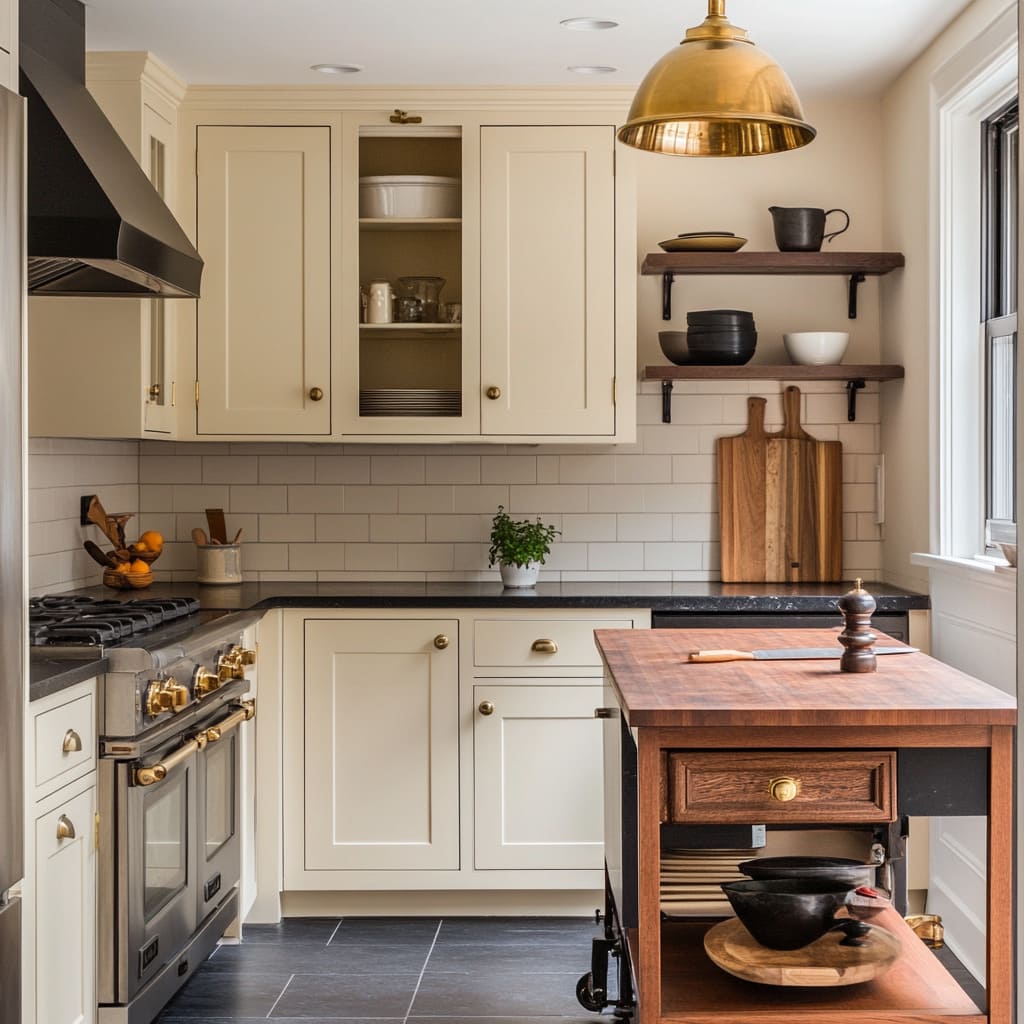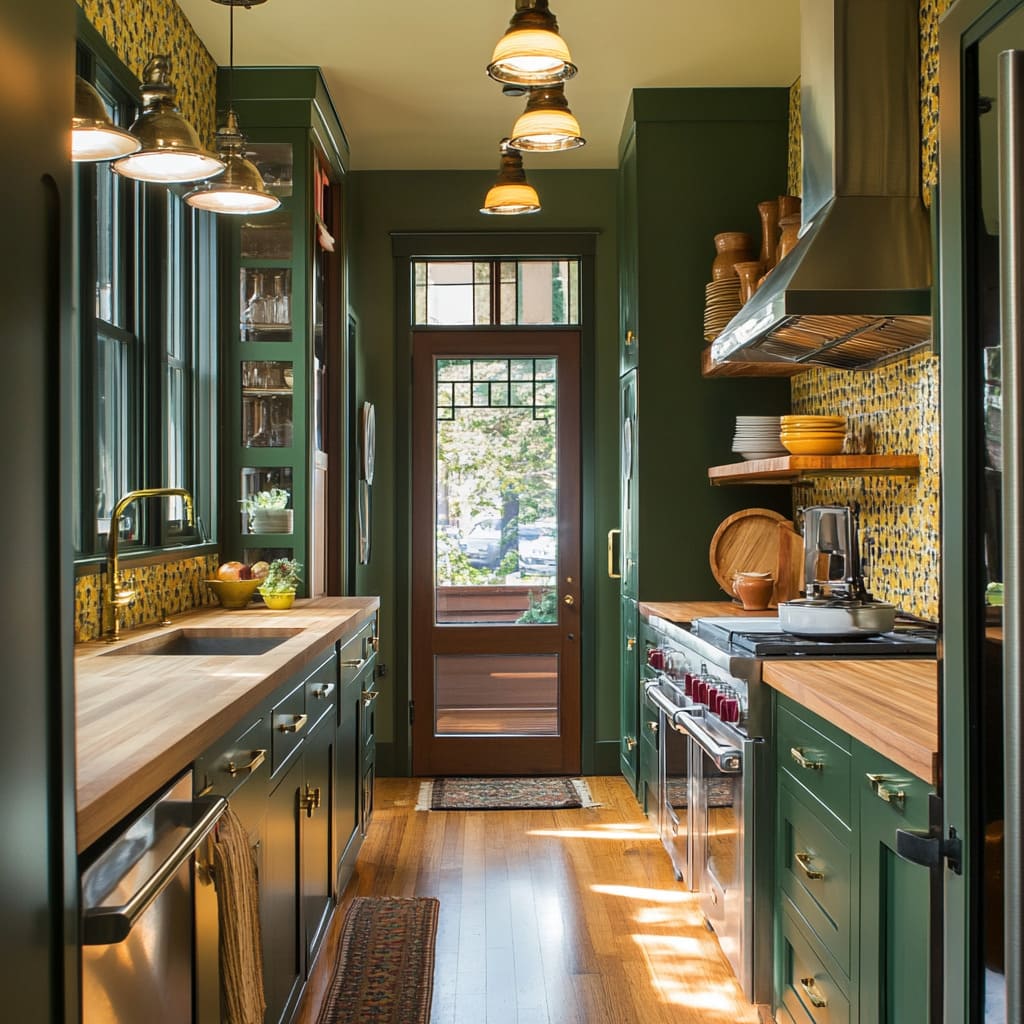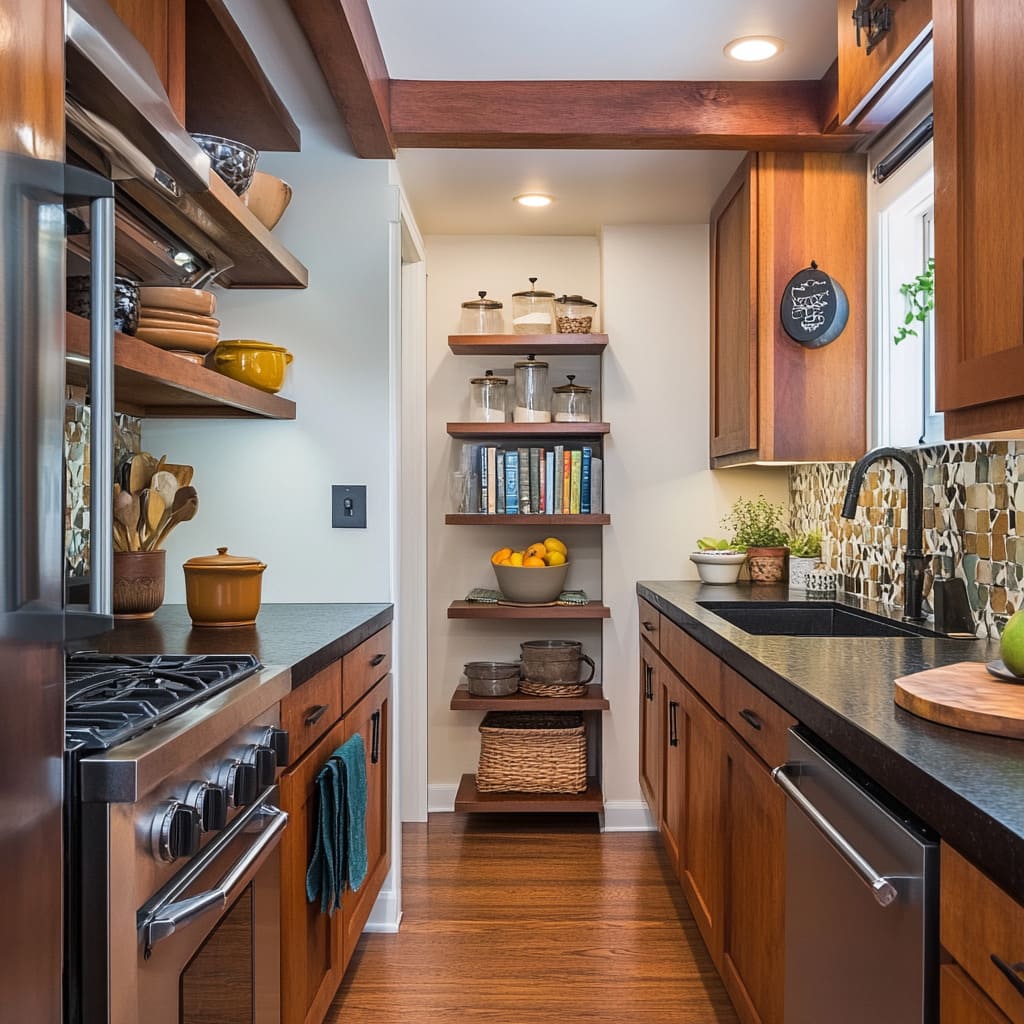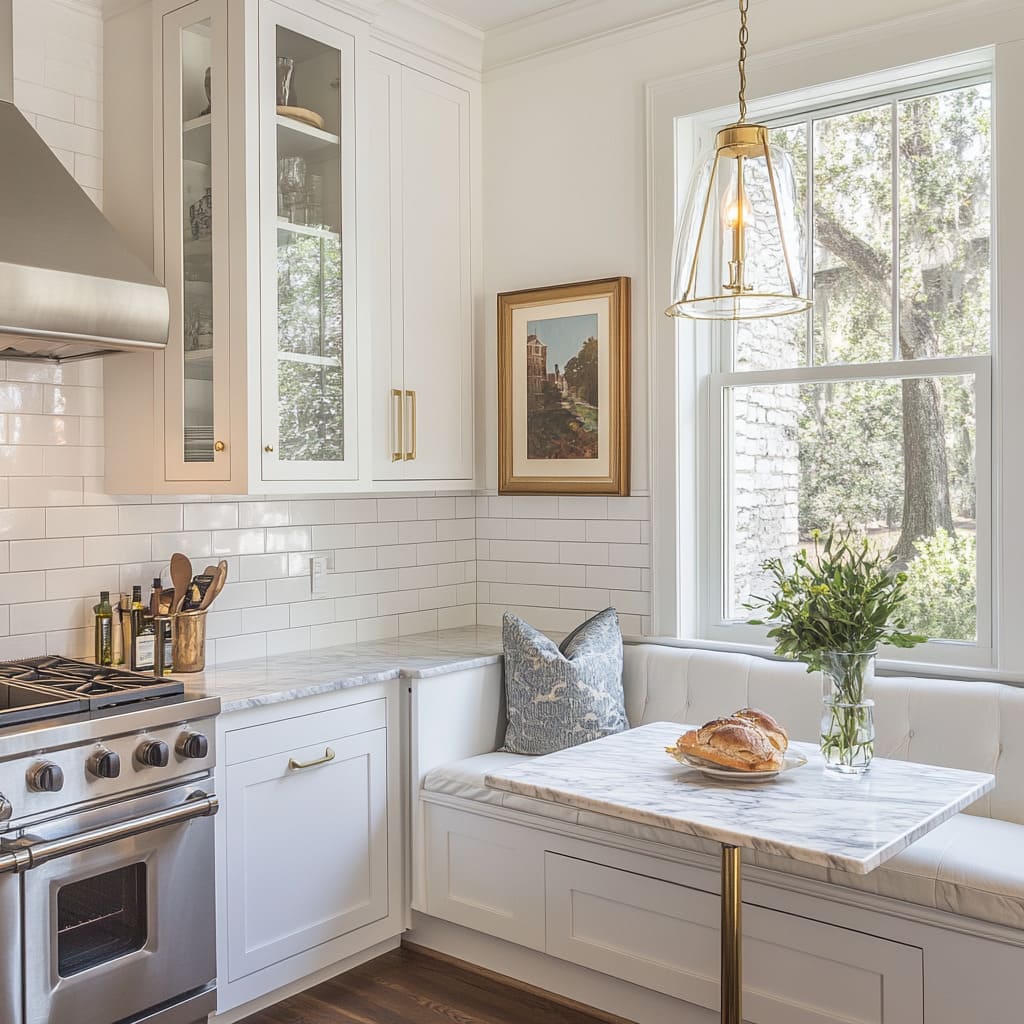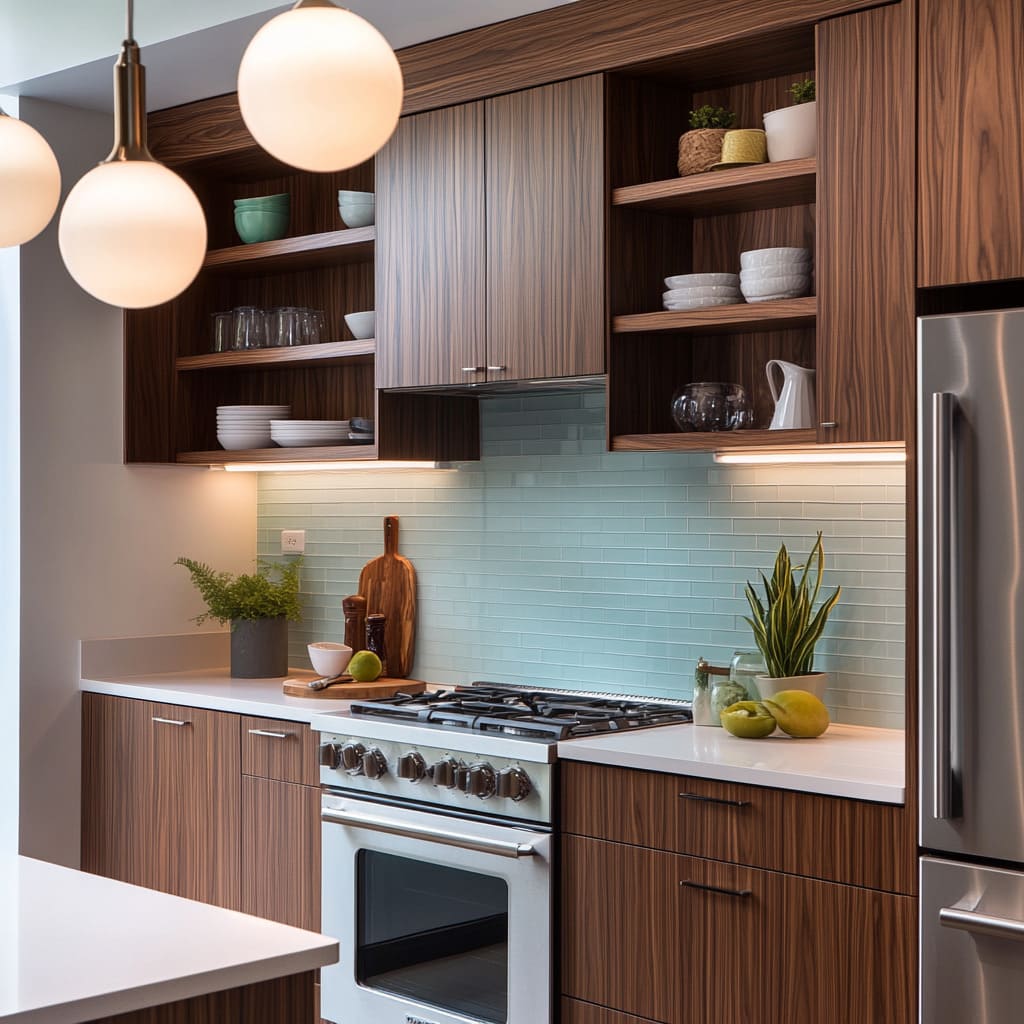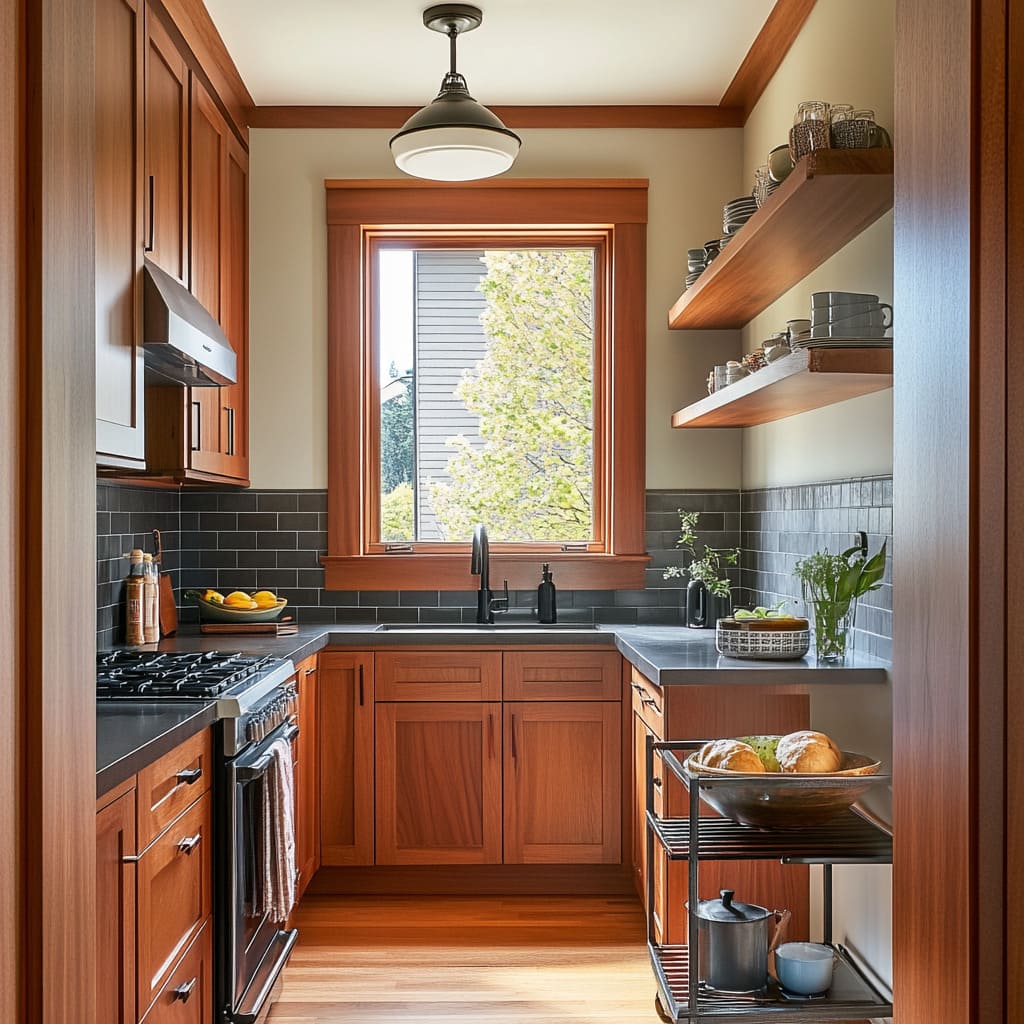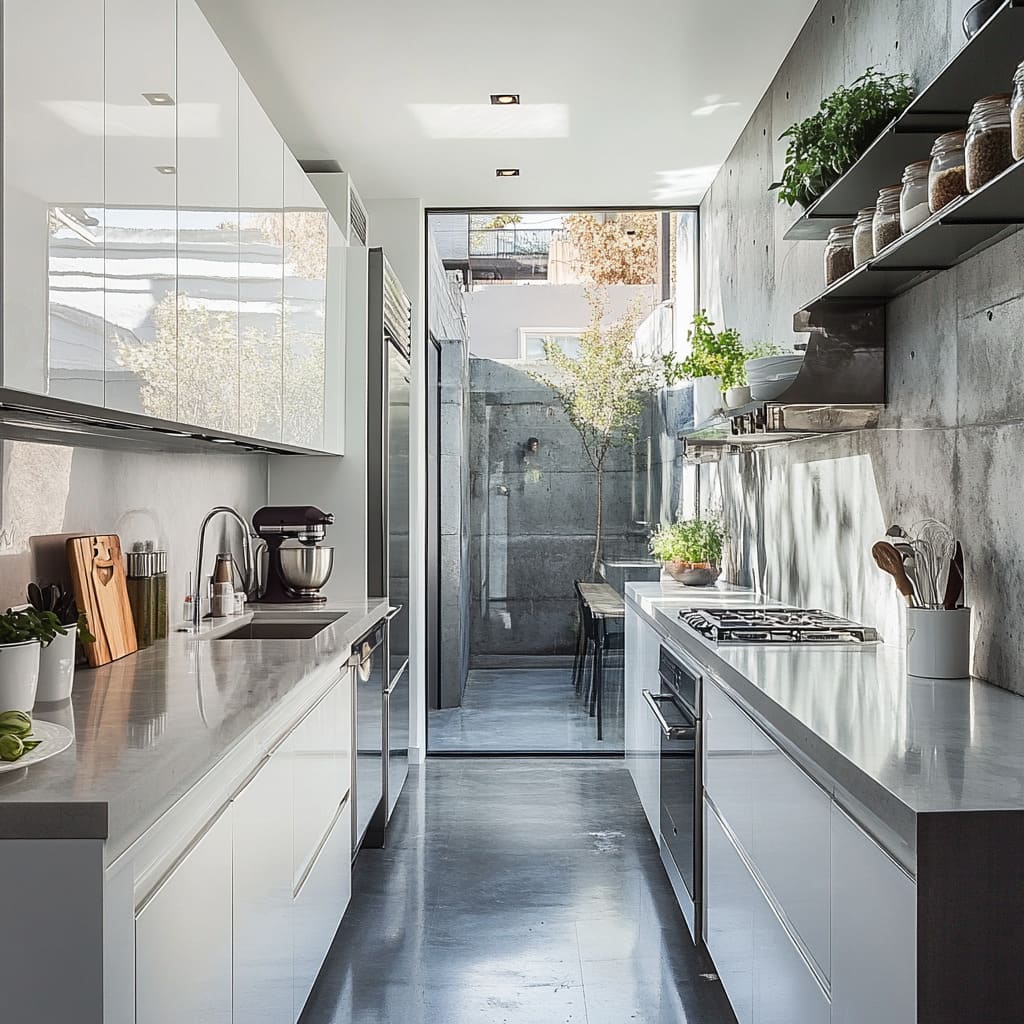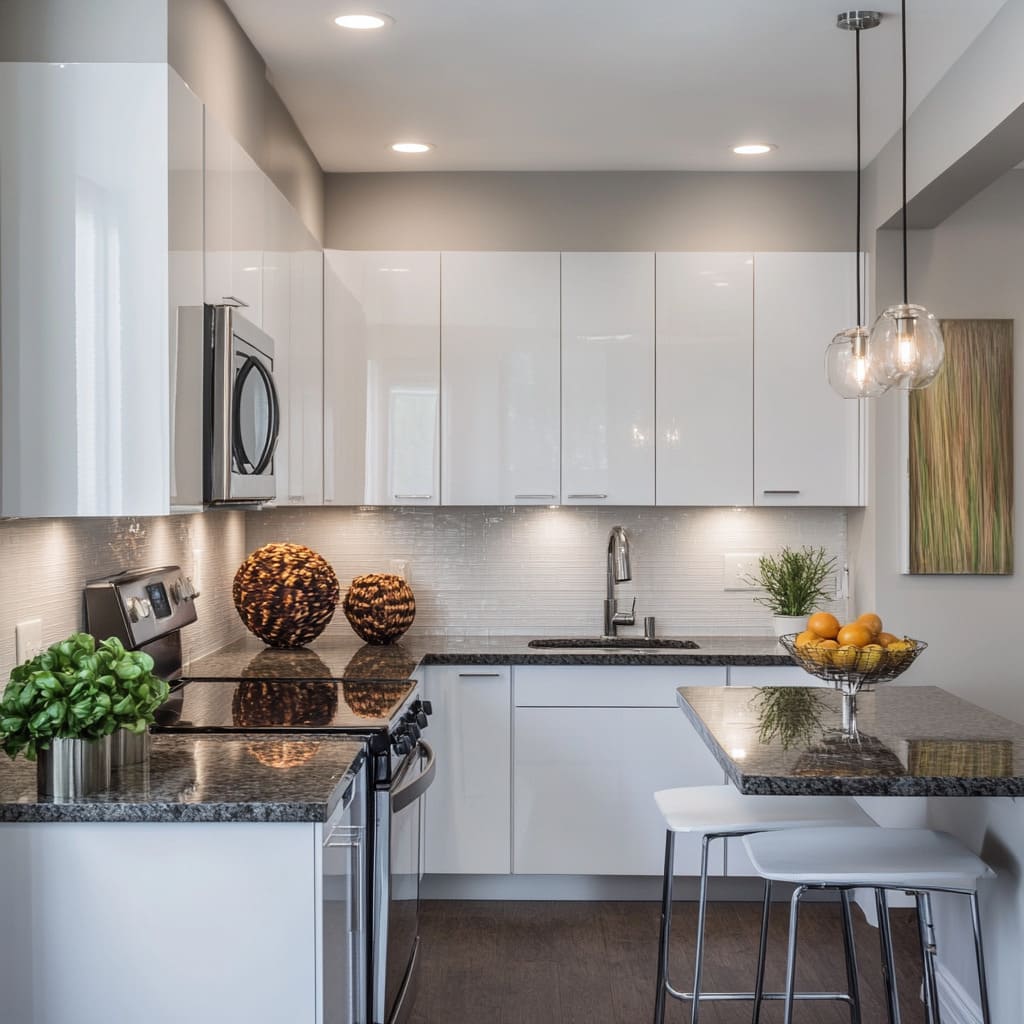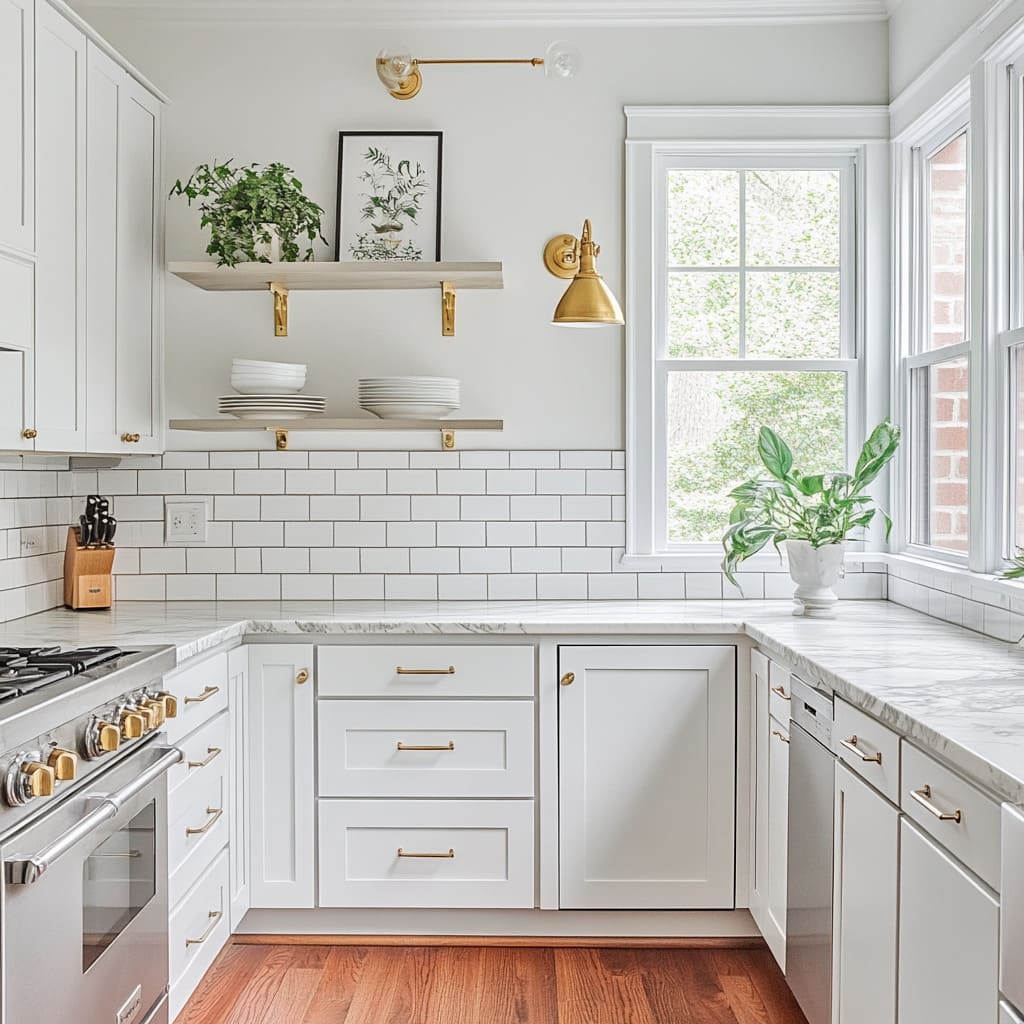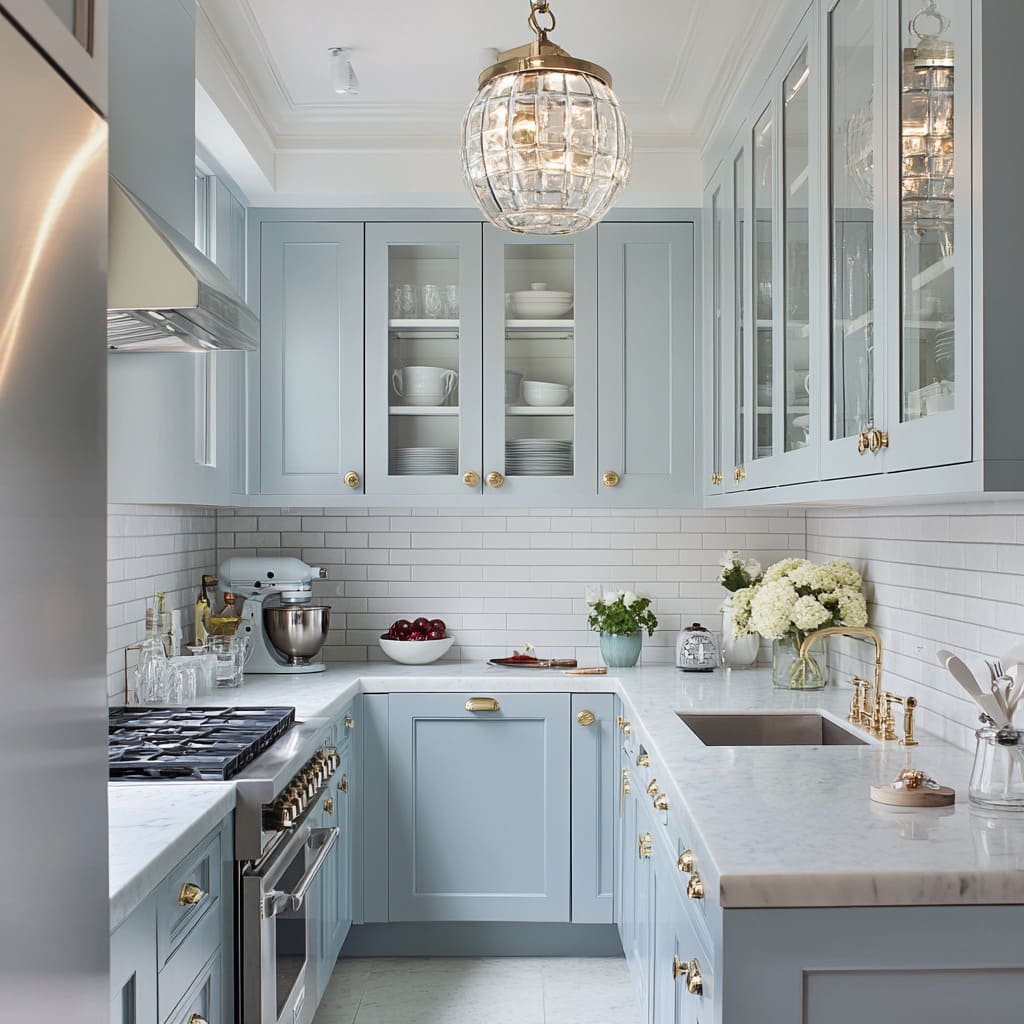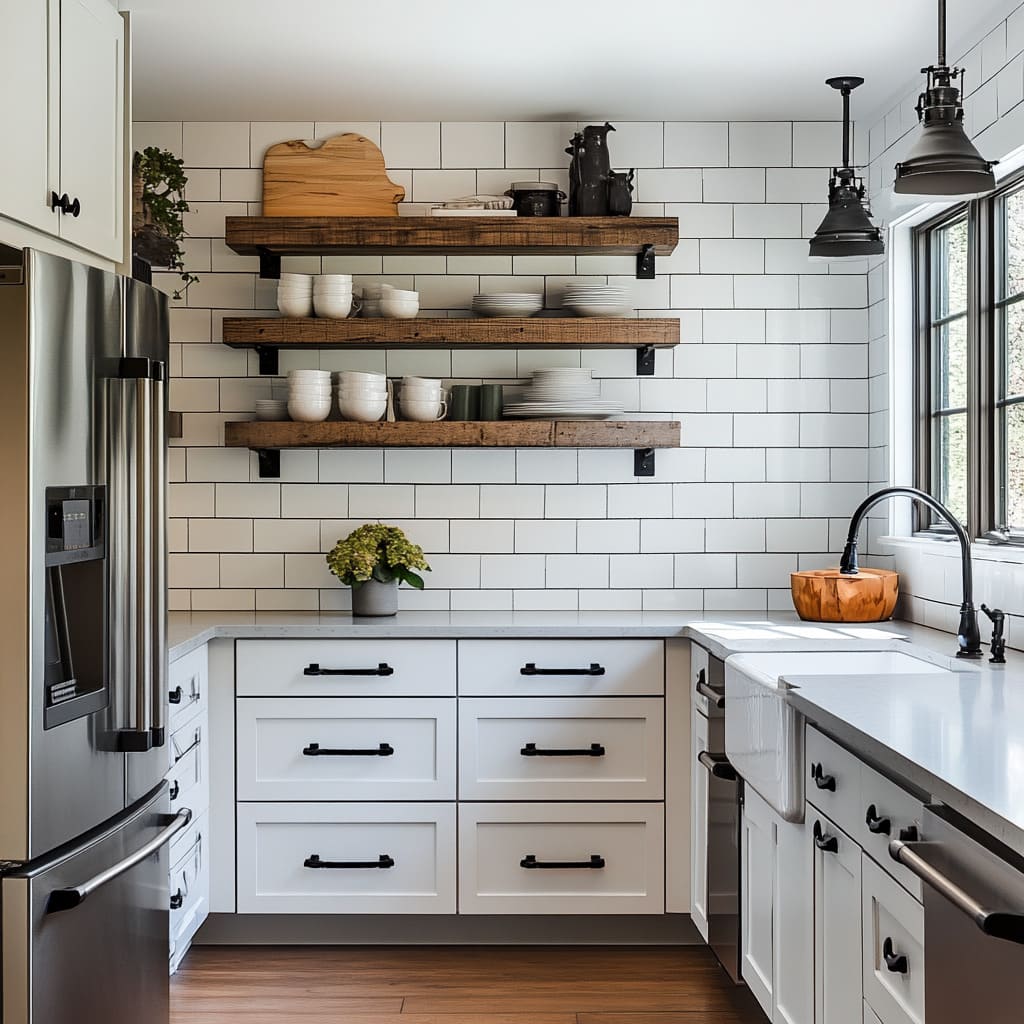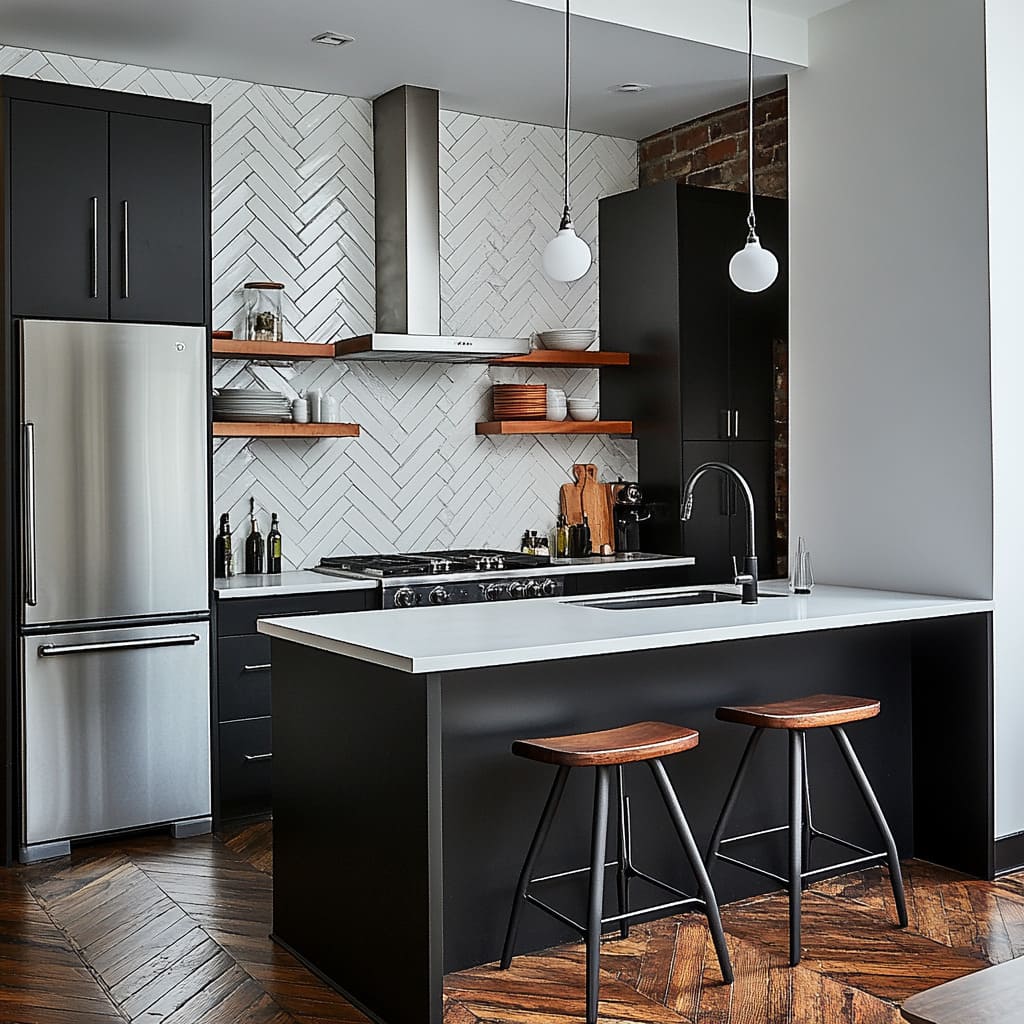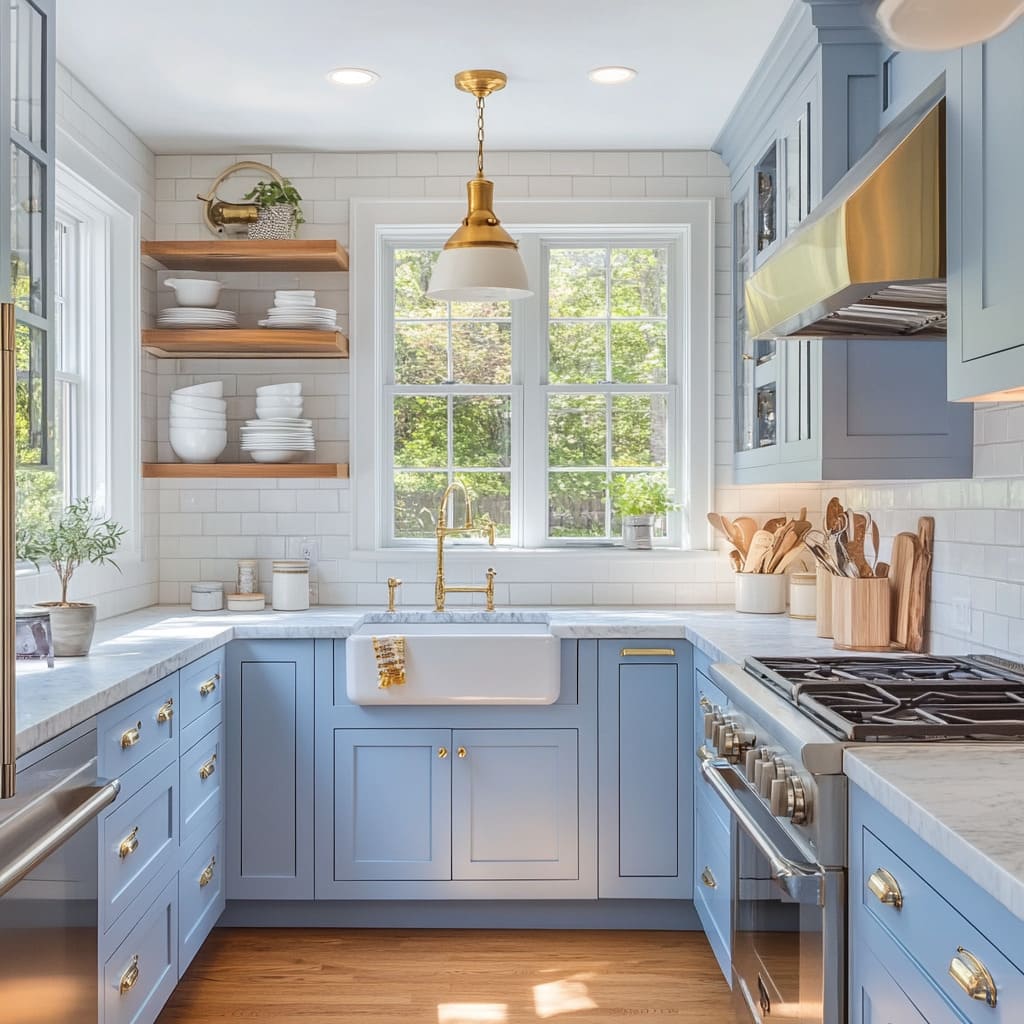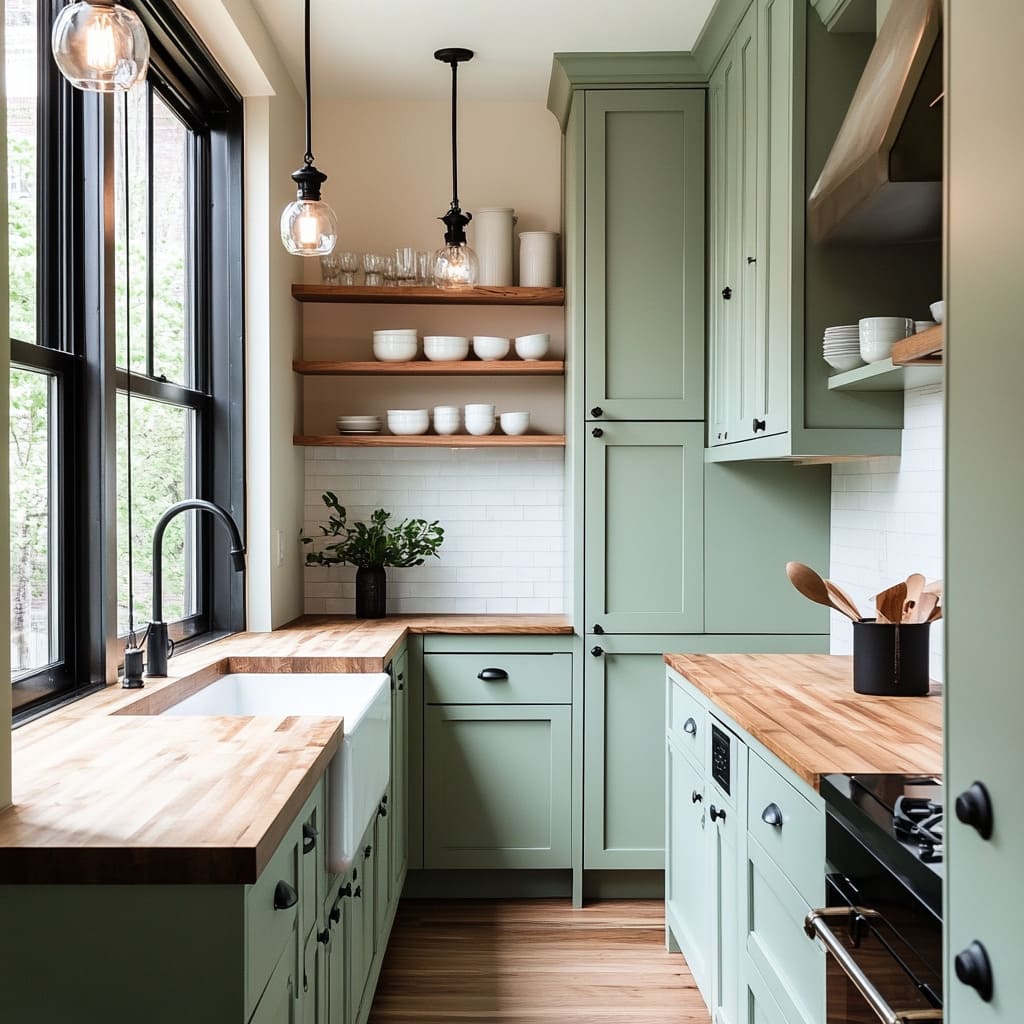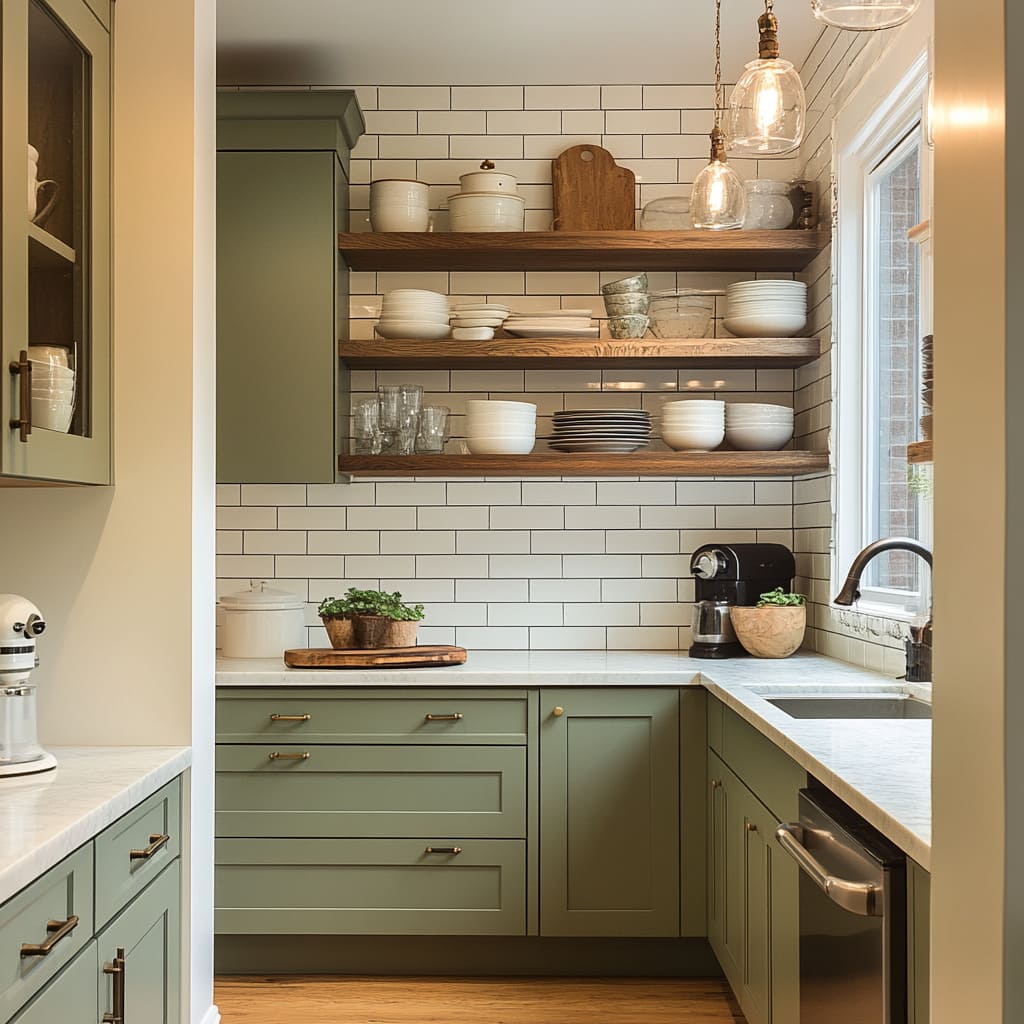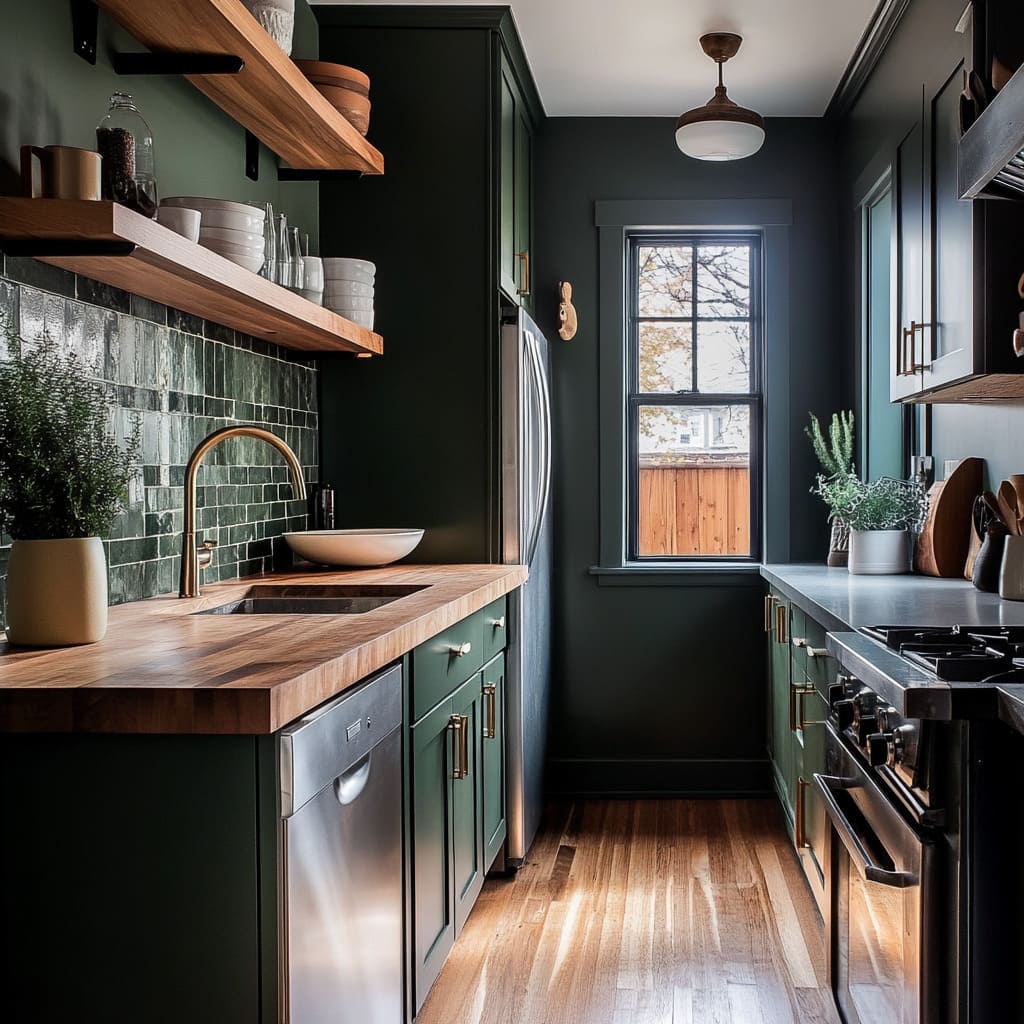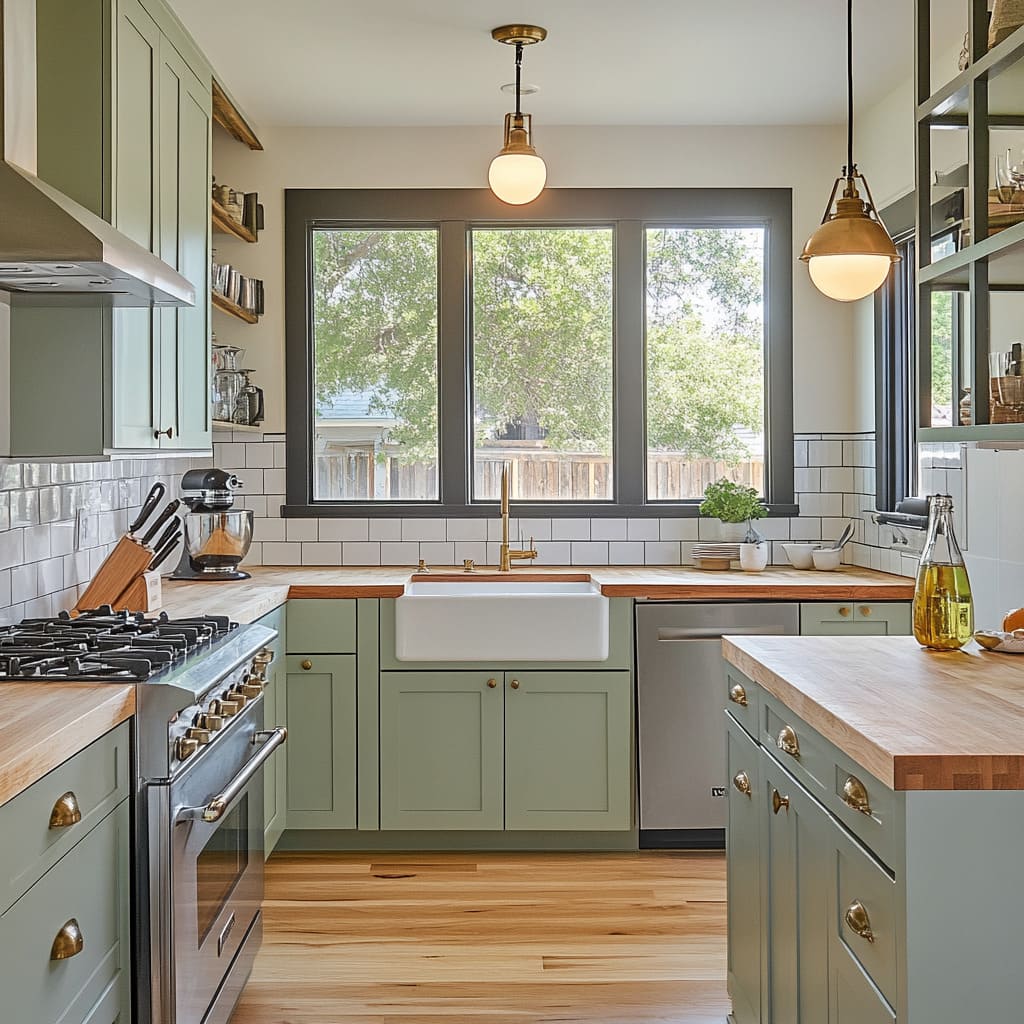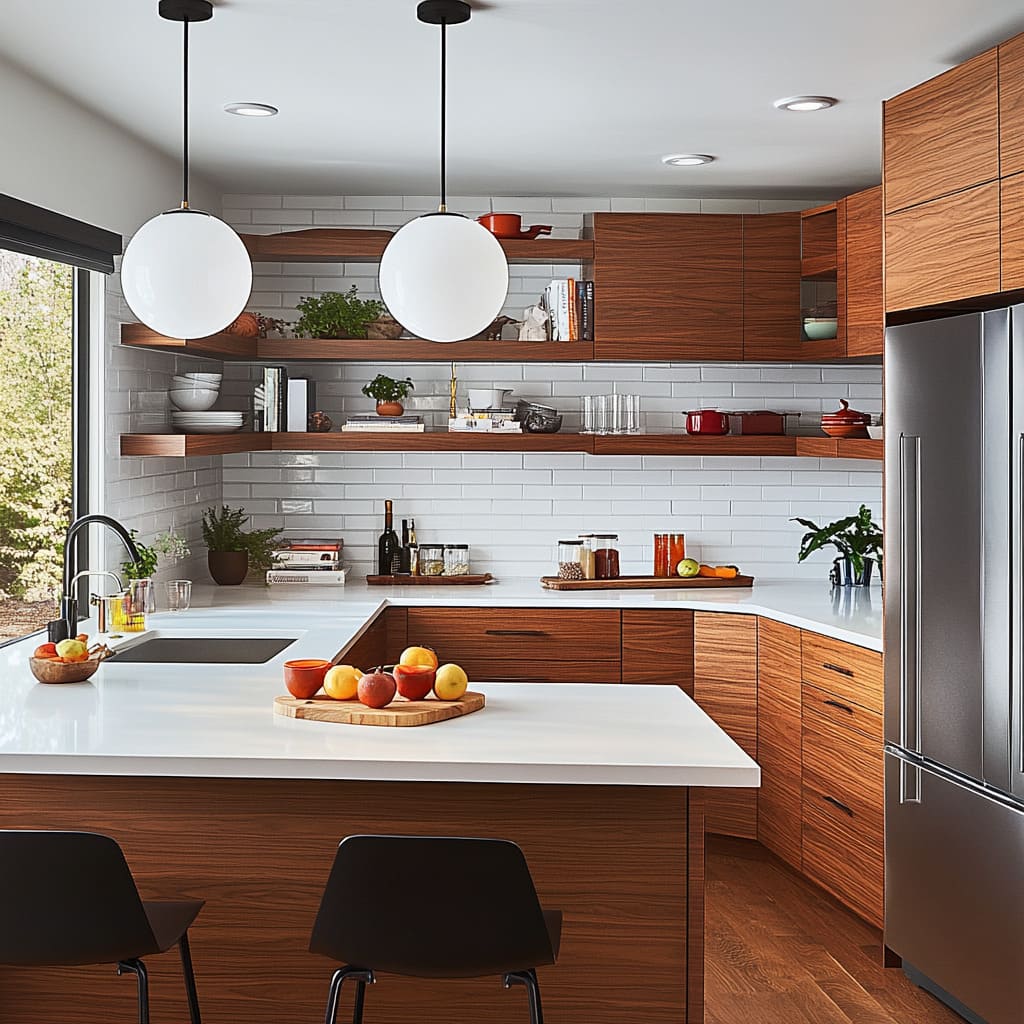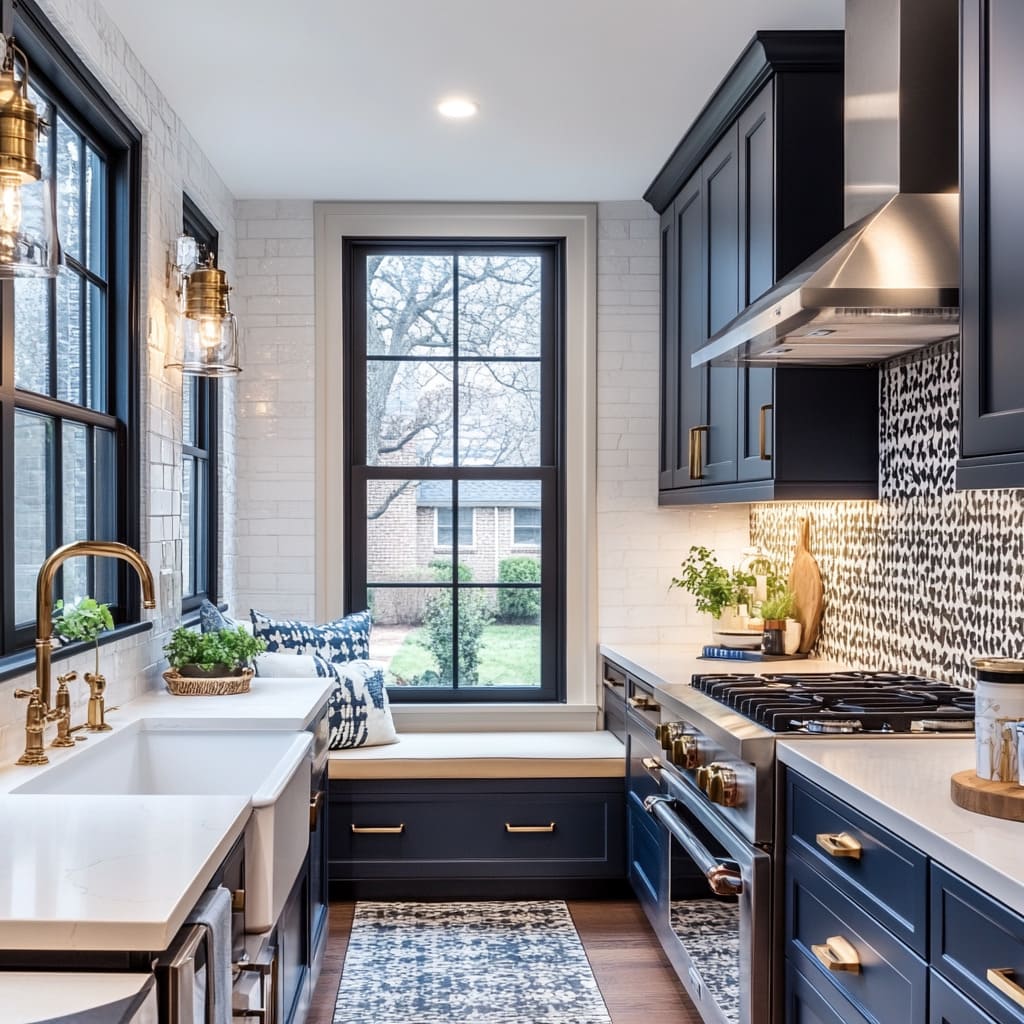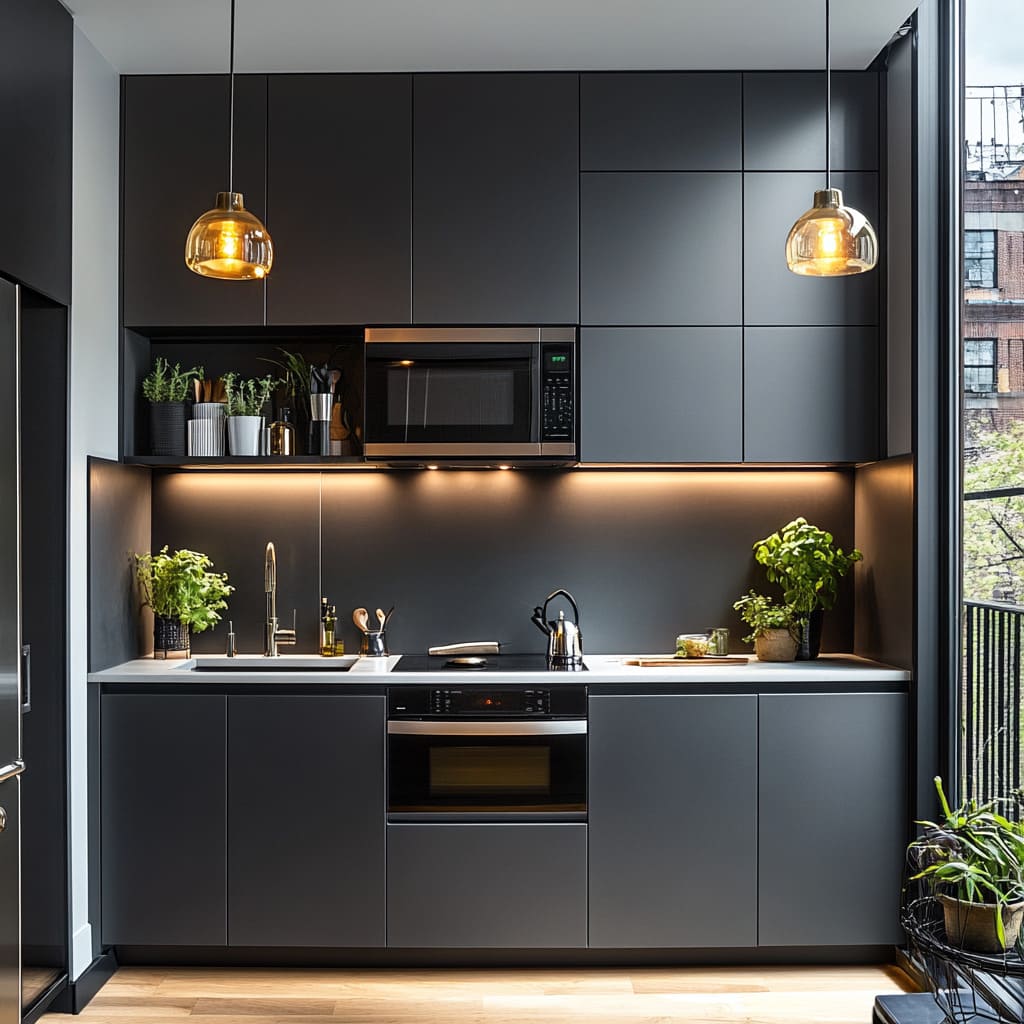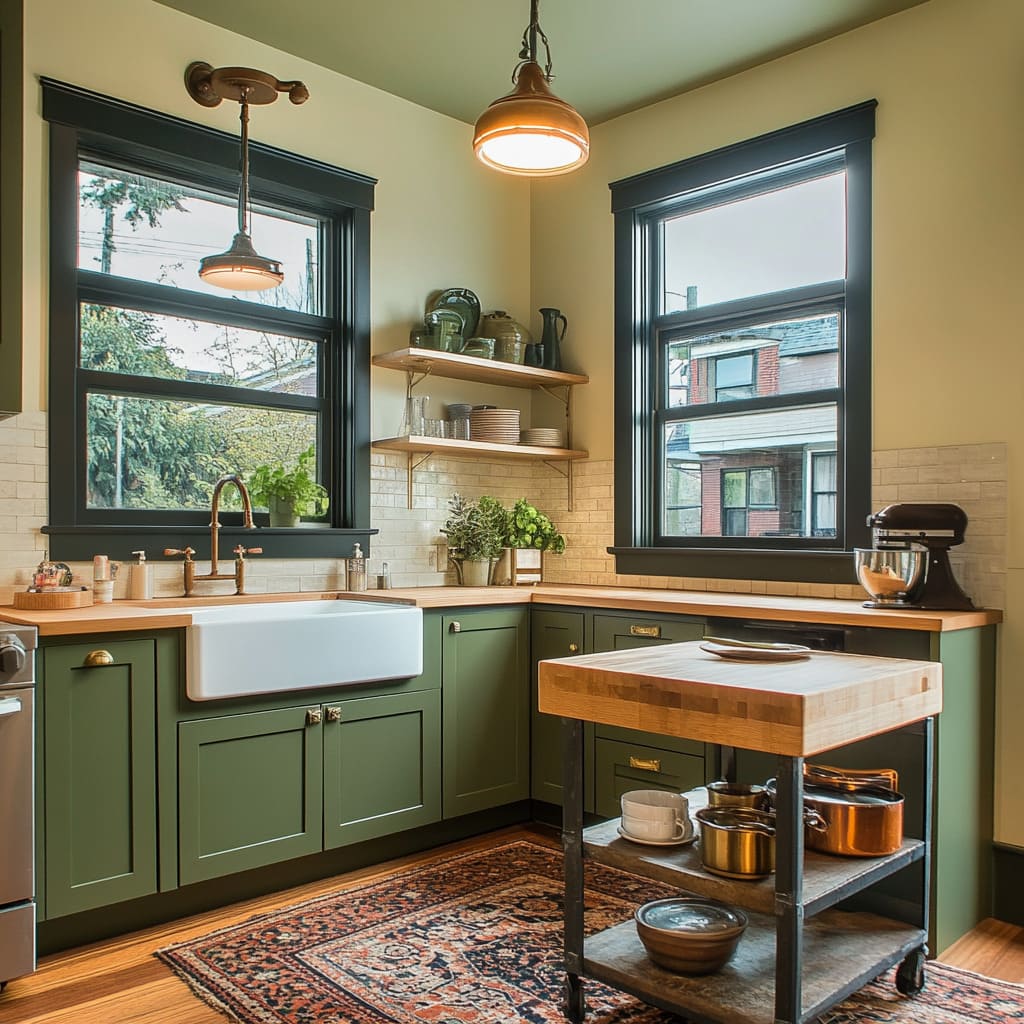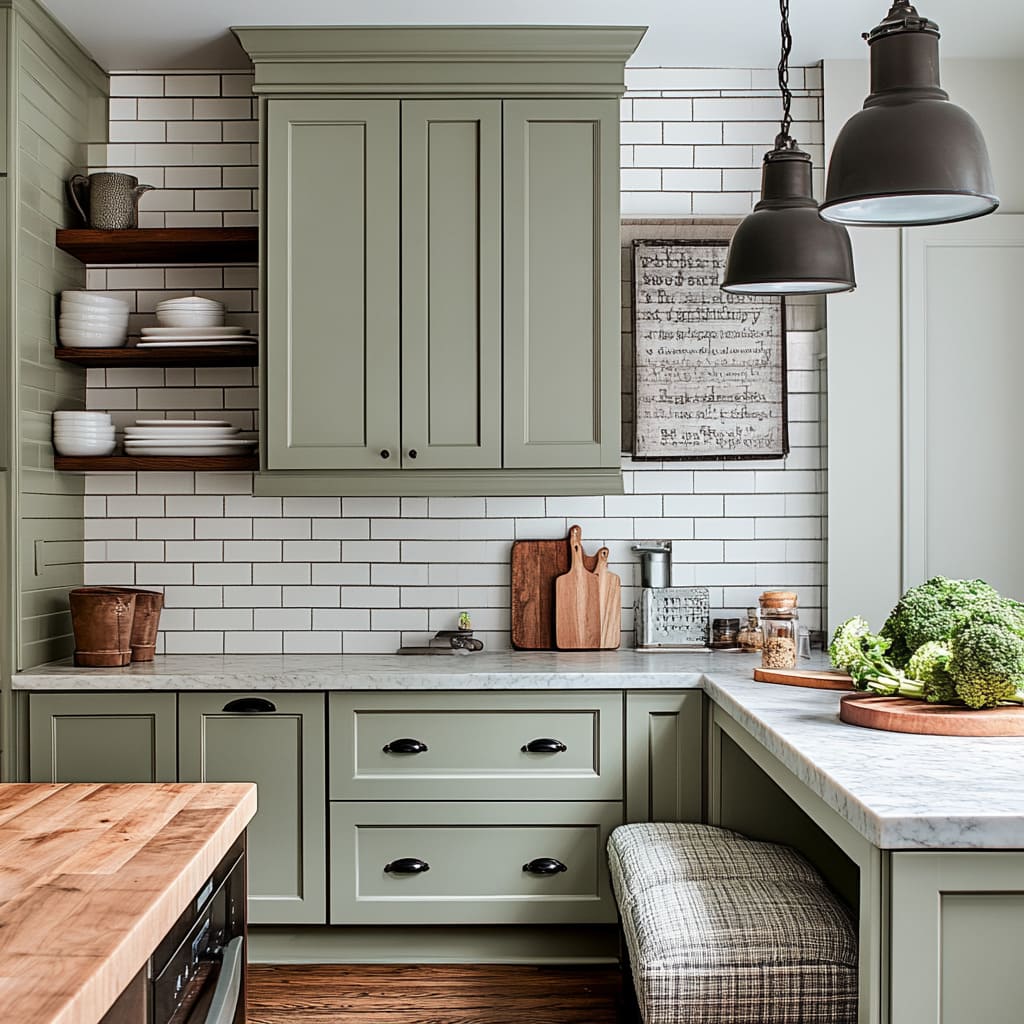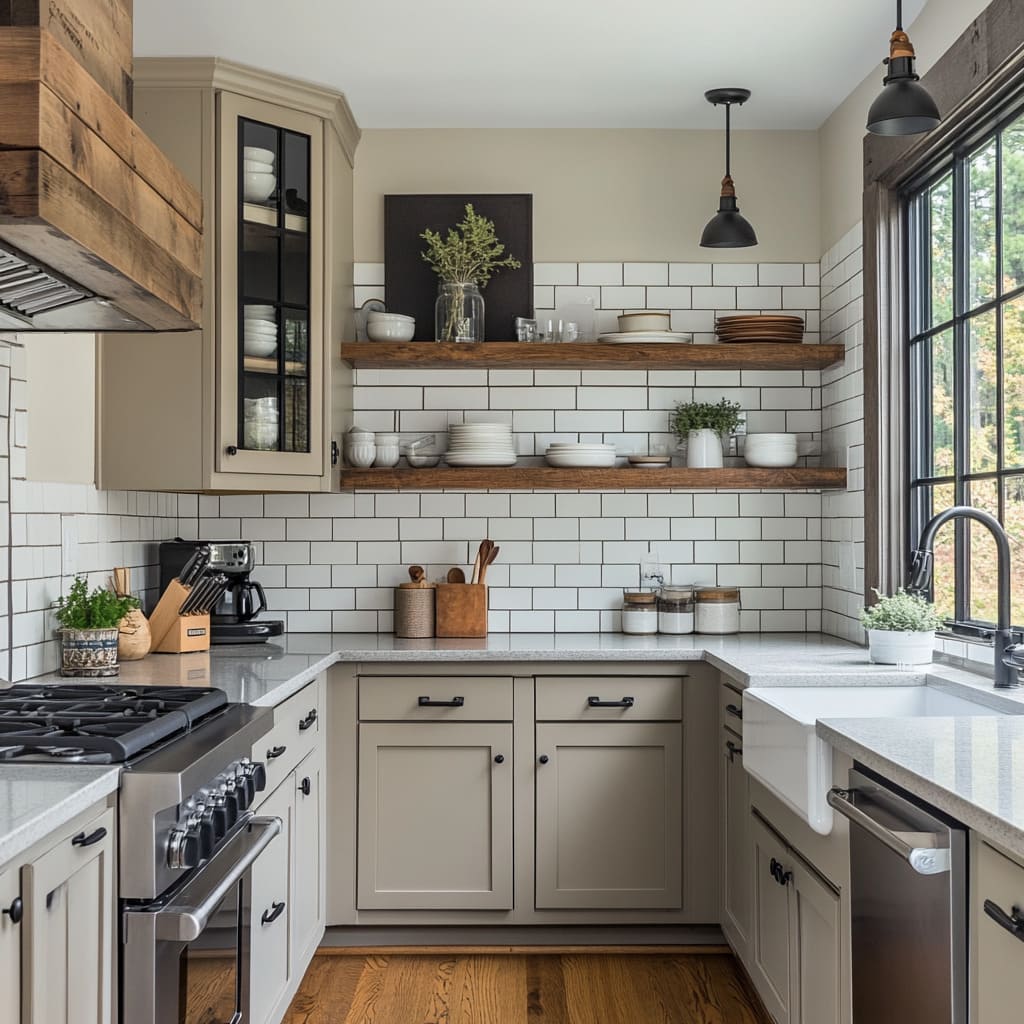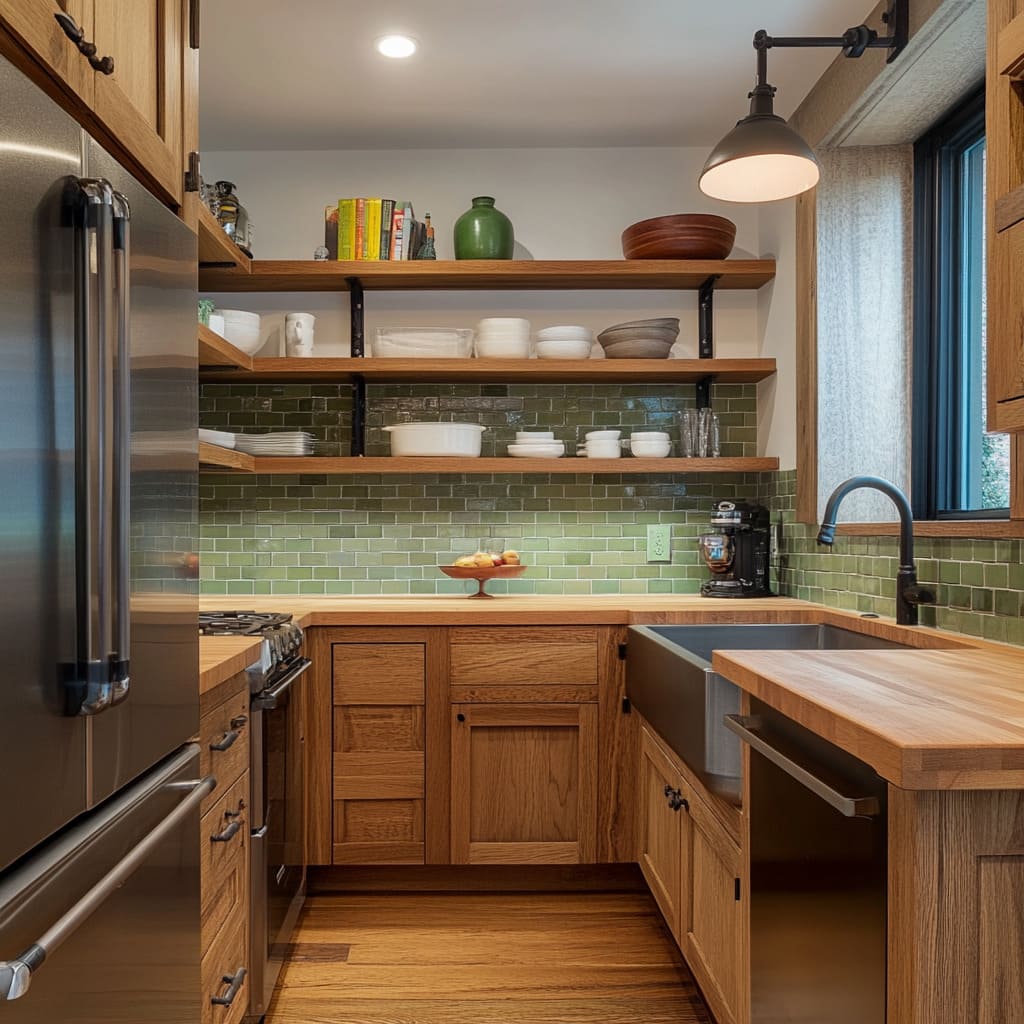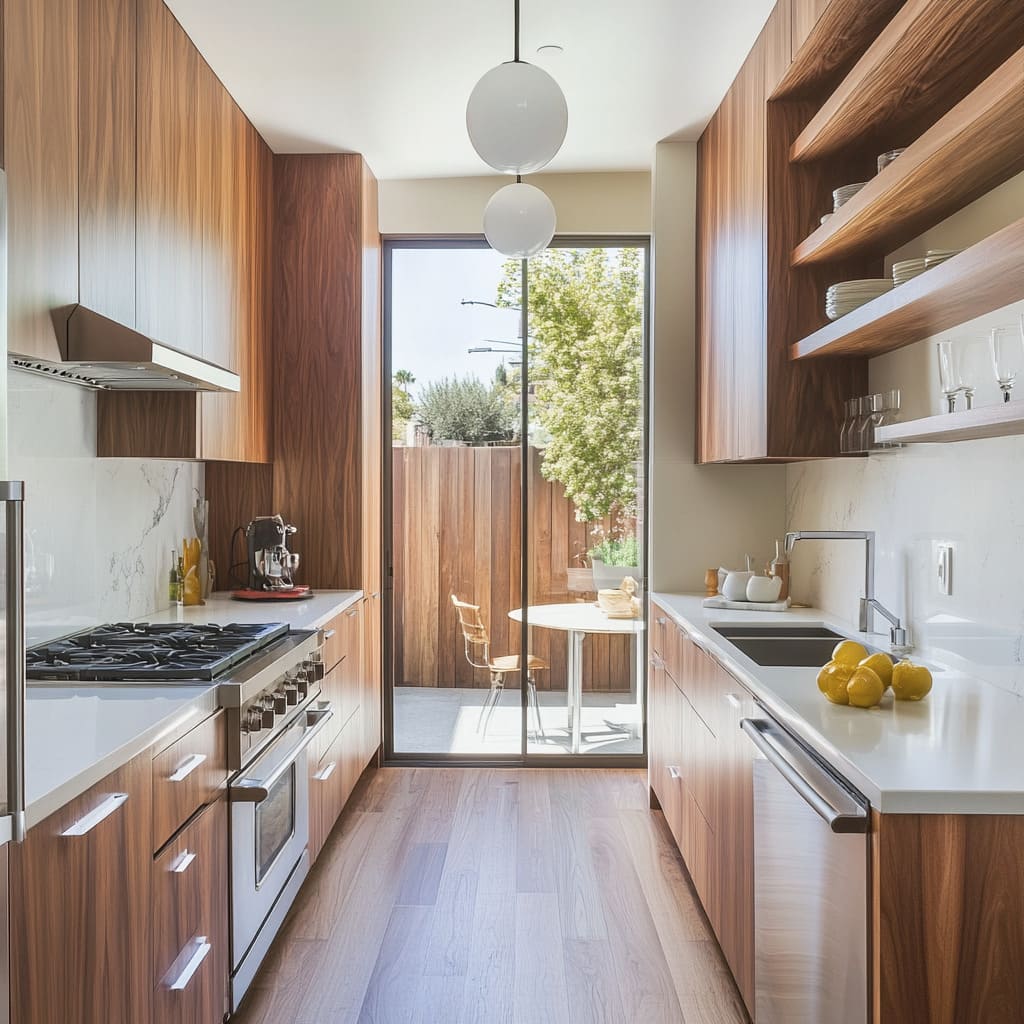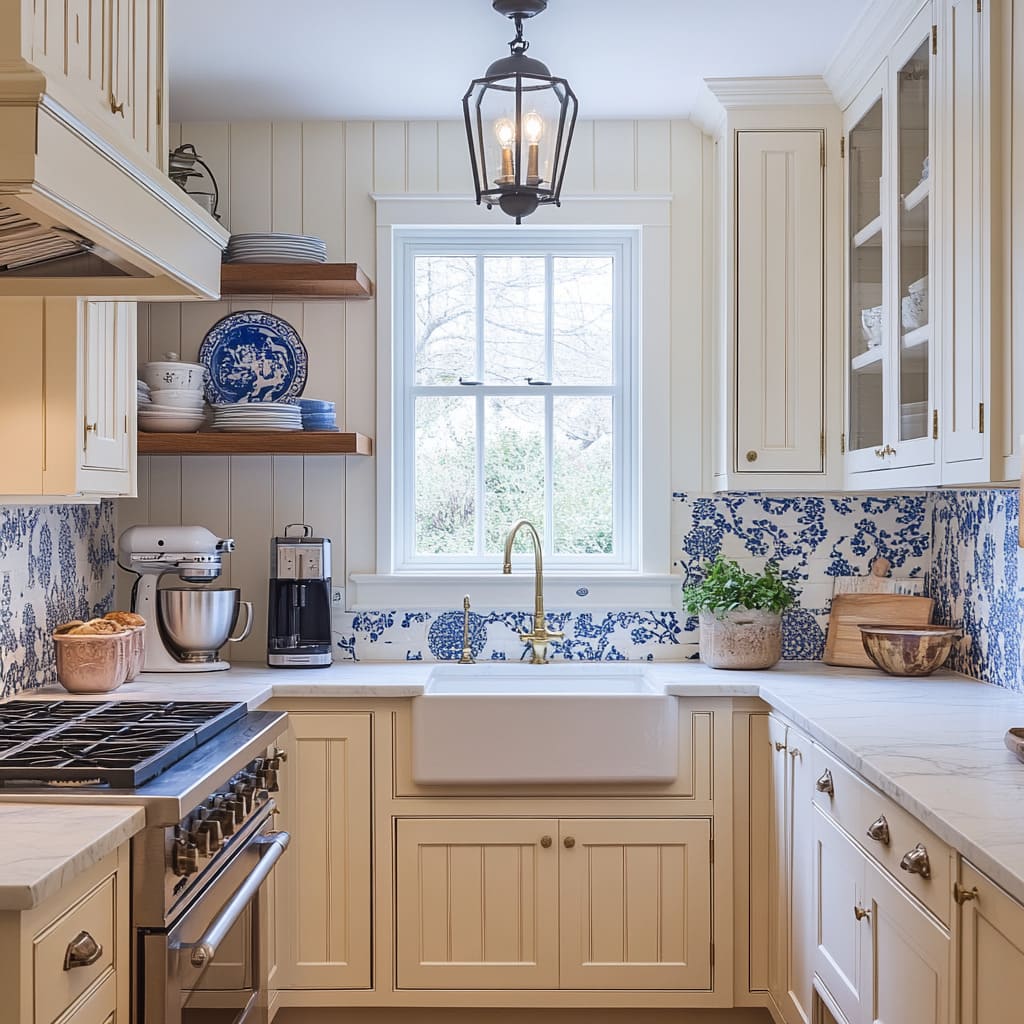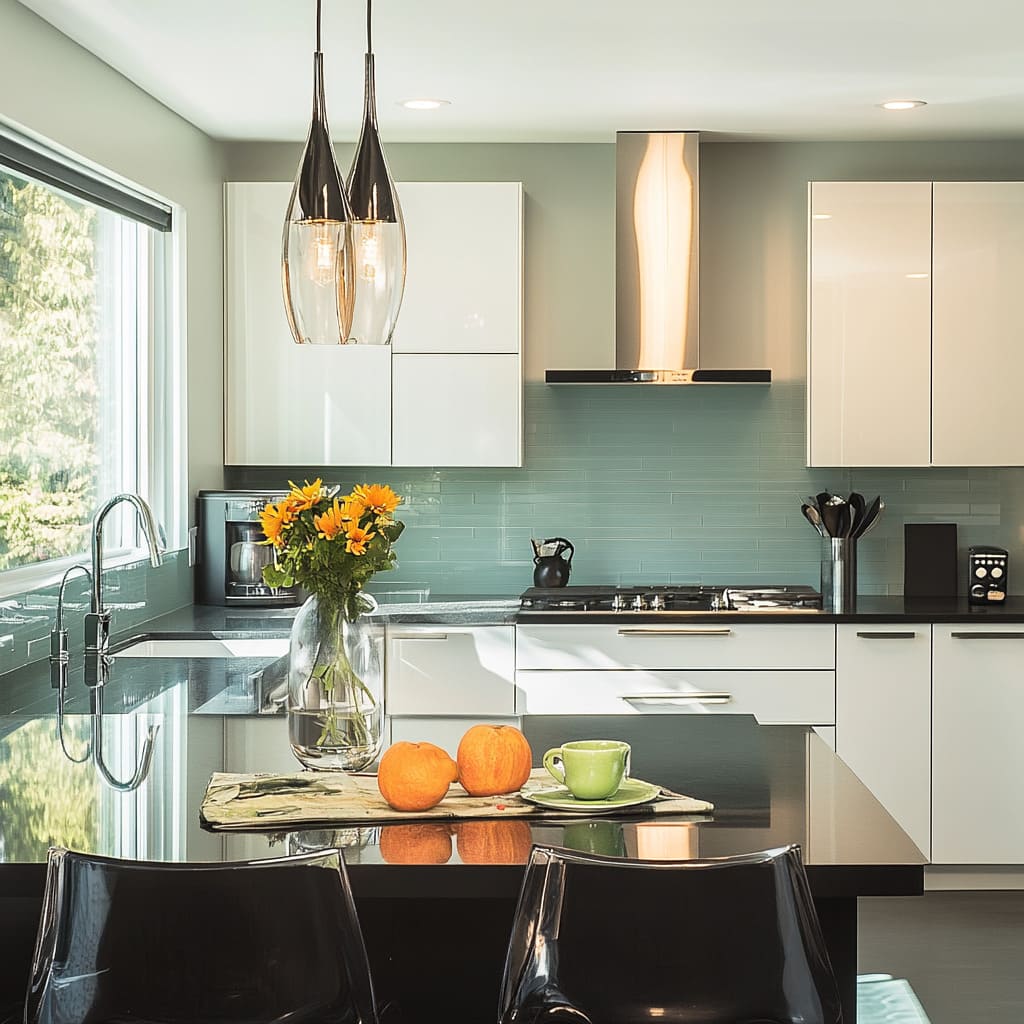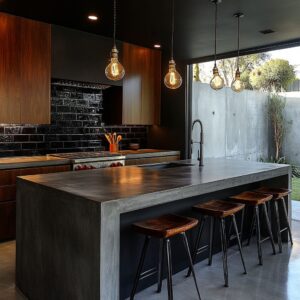When it comes to small kitchen design, suburban American homes present a unique opportunity to blend style and practicality in a compact area. Whether it’s a modern farmhouse kitchen in Austin or a mid-century modern setup in Los Angeles, these small spaces demand thoughtful planning to optimize both functionality and aesthetics.
In a world where open floor plans and spacious kitchens are often highlighted, it’s important to recognize that smaller kitchens can still be efficient, beautiful, and fully functional. The key is making every square inch count while ensuring the space complements the home’s architecture.
In suburban homes, especially those built with classic American architectural styles such as Colonial, Craftsman, or Shaker, kitchens are often compact and need creative solutions to maximize their potential. Whether you’re renovating a charming Craftsman bungalow in Seattle or refreshing a Colonial Revival kitchen in Boston, it’s crucial to work within the limitations while maintaining the character of the home.
Small kitchen remodel projects often focus on efficiency, requiring layouts that make the most of limited space and design elements that enhance rather than overwhelm. Homeowners today look for ways to merge modern conveniences with classic charm, ensuring their kitchens not only fit the home’s aesthetic but also serve practical needs.
The purpose of this guide is to offer readers practical solutions and inspiration for transforming their small kitchens. We’ll dive into various small kitchen ideas, showcasing the best ways to integrate design elements that suit the distinct architectural styles commonly found in suburban America.
From maximizing storage with deep drawers and open shelving to using compact appliances that fit seamlessly into cabinetry, the guide aims to equip homeowners with actionable tips for crafting an efficient and stylish kitchen. Each section will present specific examples tailored to styles such as Modern Farmhouse, Colonial Revival, and Shaker, among others, ensuring that readers can find ideas that resonate with their personal taste and the character of their home.
Outline of Key Elements: What the Guide Will Cover
To make this guide both comprehensive and engaging, it is divided into specific sections that address the critical aspects of small kitchen design ideas:
- Efficient Layouts for Small Kitchens: Choosing the right layout is essential for making the most of a compact space. This section will explore popular configurations such as the galley, L-shaped, U-shaped, and single-wall layouts. Each layout has its benefits, and understanding which one suits a particular home style can make a significant difference in overall functionality.
- Storage Solutions: Effective storage is key in small kitchens, and this section will discuss various options like pull-out racks, corner units, and floating shelves that keep the kitchen tidy while maximizing available space.
- Styling According to Architectural Style: Each architectural style has unique features that influence the kitchen design. We’ll explore how different elements like cabinetry finishes, countertops, and backsplash choices can be tailored to complement styles such as Craftsman, Shaker, Colonial, and Mid-Century Modern.
- Lighting and Color Choices: The right lighting and color palette can transform a small kitchen, making it feel larger and more inviting. This section will cover lighting strategies, from under-cabinet LEDs to pendant lights, and color schemes that align with each architectural style.
By addressing these critical areas, the article will guide homeowners through the process of designing or remodeling their small kitchens, helping them find the right balance between style and practicality. Whether you’re looking to enhance a single-wall kitchen in a modern loft or update a galley kitchen in a colonial-style home, this guide offers specific advice for every situation, ensuring the end result is a kitchen that not only looks good but also works well for everyday living.
Tailoring Small Kitchens to Architectural Styles
When it comes to small kitchen design, it’s essential to align the aesthetic and functionality with the home’s architectural style. By incorporating design elements that reflect the heritage and charm of a particular style, homeowners can create a cohesive look that enhances the overall character of their space.
Below, we explore how to tailor small kitchens to various popular architectural styles found in suburban American homes, offering practical and creative ideas that make the most of compact kitchens.
Craftsman-Style Kitchens
Craftsman homes, known for their emphasis on natural materials and handcrafted details, require kitchens that stay true to this spirit. In a small Craftsman kitchen, the goal is to integrate these elements in a way that feels authentic yet functional.
Wood cabinetry is a hallmark of the Craftsman style, and in small spaces, opting for rich tones like cherry or oak can create a warm and inviting atmosphere. These cabinets can be paired with soapstone countertops, which not only align with the natural look but also offer durability and a tactile quality that suits everyday use.
For the backsplash, artisanal tiles—such as handmade ceramics in earthy tones—can add a touch of craftsmanship and visual interest without overpowering the space. To enhance functionality, especially for those looking for very small kitchen ideas on a budget, deep drawers and pull-out pantry units help keep the area organized without sacrificing style.
The result is a kitchen that feels both rooted in tradition and fully equipped for modern living.
Modern Farmhouse Kitchens
Modern farmhouse kitchens have gained popularity for their blend of rustic charm and industrial flair. These kitchens mix natural elements with contemporary touches, making them ideal for creating a cozy yet functional atmosphere, even in a small footprint.
Incorporating open shelving is an effective way to maintain an open feel in a compact kitchen while showcasing favorite dishes, glassware, or small plants. To keep things cohesive, consider using reclaimed wood shelves for a touch of rustic character.
Subway tile backsplashes, particularly those with a matte finish, create a clean and classic look that balances the farmhouse aesthetic with a modern touch. For lighting, industrial-style pendant lights are a popular choice, adding a hint of vintage charm.
Pairing these elements with compact appliances like slim refrigerators or built-in microwaves keeps the space functional. If you’re seeking tiny kitchen ideas for modern farmhouses, incorporating mobile islands or folding tables can add versatility without cluttering the layout.
This approach maintains the farmhouse appeal while making the most of a small area.
Colonial and Colonial Revival Kitchens
Colonial and Colonial Revival kitchens evoke a sense of timeless elegance, making them a perfect fit for homes with a traditional aesthetic. These kitchens often rely on classic color schemes and design elements that emphasize simplicity and historical charm.
Using decorative tiles, such as blue and white patterns inspired by colonial designs, can add visual interest to the backsplash without overwhelming the space. For cabinetry, navy blue or soft cream tones work well, providing a sophisticated and polished look that feels appropriate for a colonial setting.
Glass-front cabinets are an excellent option for small kitchens, as they open up the space visually while providing a place to display fine china or decorative pieces. To complete the look, opt for brass hardware, which adds a hint of warmth and historical character.
This approach ensures that even the smallest colonial kitchens retain their charm while offering modern conveniences.
Mid-Century Modern Kitchens
Mid-century modern kitchens are all about clean lines and simplicity, making them a great choice for compact spaces like bungalows or townhouses. The goal here is to keep the design streamlined while incorporating a few key retro elements that capture the style’s essence.
Flat-panel wood cabinetry, especially in walnut or teak, is a hallmark of mid-century design and works beautifully in small kitchens. These cabinets not only maximize storage but also maintain a sleek, uncluttered appearance.
To add a touch of retro flair, globe pendant lights above the kitchen island or dining area bring both style and functional lighting, creating a focal point without taking up much visual space.
Open shelving is also a common feature in mid-century kitchens. By using slim metal or wood shelves, homeowners can display vintage dishware or small decorative plants without closing off the space.
For a mid-century backsplash, consider simple glass panels or small mosaic tiles in vibrant colors. If you’re looking for simple kitchen design ideas within this style, a focus on minimalism and efficient use of materials is key, ensuring the space feels light, open, and functional.
Shaker-Style Kitchens
Shaker-style kitchens prioritize simplicity, craftsmanship, and practicality—qualities that are especially important in small kitchen designs. The straightforward approach of Shaker design makes it easy to create a cohesive and efficient kitchen that feels timeless and elegant.
Classic Shaker cabinetry, typically in soft tones like sage green, dove gray, or white, is a staple of this style. In small kitchens, these cabinets can be extended to the ceiling to maximize vertical space, creating ample storage while maintaining the clean lines characteristic of Shaker design.
Pairing the cabinetry with marble countertops enhances the look, offering a touch of sophistication that doesn’t overwhelm the kitchen’s simplicity.
For those exploring simple kitchen design elements, incorporating a built-in breakfast nook is a smart way to make the most of a small space. A built-in nook not only adds seating but also offers hidden storage beneath the bench, making it both a functional and aesthetically pleasing feature.
Pendant lighting with a classic, minimalist design can complete the look, ensuring that the kitchen feels both inviting and practical, fitting perfectly within a Shaker-style home. By aligning small kitchen designs with these architectural styles, homeowners can transform their spaces into beautiful, functional areas that enhance the character of their homes.
From Craftsman to Shaker, each style offers unique opportunities to create a compact kitchen that feels intentional, stylish, and well-suited to the demands of modern living.
Storage Solutions: Making the Most of Small Spaces
When dealing with limited kitchen space, storage becomes a priority. Small kitchens require smart, strategic solutions that maximize every available inch while keeping the design cohesive and attractive.
Let’s explore effective methods for optimizing storage, incorporating multifunctional furniture, and integrating compact appliances in kitchen designs for small kitchens.
Maximizing Cabinet Storage
One of the most efficient ways to maximize storage in a small kitchen is by choosing cabinetry that reaches the ceiling. High cabinets make use of vertical space, offering additional storage for items not used daily while keeping the countertop area clear for cooking and prep work.
This approach not only maximizes capacity but also draws the eye upward, making the room feel larger.
Solutions like pull-out pantry racks are perfect for organizing ingredients and snacks in a narrow space. These racks utilize slim, vertical areas that might otherwise be wasted.
Deep drawers are another fantastic addition, especially for storing bulky pots, pans, and dishes. They provide easy access and visibility, ensuring that nothing is lost at the back of a cabinet.
For tricky corners, corner units with rotating shelves or pull-out trays are great options, making hard-to-reach spots practical and accessible. These features transform tight spaces into functional areas, enhancing the overall utility of the kitchen.
Open Shelving and Display Options
Open shelving is an excellent choice for small kitchens, creating an airy and open feel by removing the visual bulk of traditional upper cabinets. This approach works particularly well when you want to show off your personality through ceramics, glassware, or decorative elements.
Open shelves keep the kitchen from feeling confined while adding character and charm. To make the most of this style, it’s important to organize shelves thoughtfully.
Mixing functional items, like dishes and glassware, with decorative pieces such as small potted plants or framed artwork, adds a personal touch. For those who appreciate a rustic or farmhouse look, wooden shelves with metal brackets bring warmth and texture, creating a welcoming environment.
Meanwhile, homeowners aiming for a minimalist aesthetic can opt for sleek metal or white shelves to maintain a clean and simple vibe. The key is balancing utility and decoration, ensuring the shelves serve both a functional and aesthetic purpose.
Movable and Multifunctional Furniture
In compact kitchens, furniture that can serve multiple purposes or be moved when needed is invaluable. Rolling carts, for example, are perfect additions.
They can function as extra prep space when needed, then be rolled aside to make room for other activities. These carts are also ideal for storing items like spices, cookbooks, or small appliances, keeping them within reach but not crowding countertops.
Foldable dining tables are another smart solution, especially for homes with single-wall or galley layouts. These tables can be extended for meals or tucked away when not in use, freeing up space for movement.
Small kitchen island ideas also play a crucial role in multifunctional kitchen setups. For very compact spaces, consider a movable island that can double as both a prep station and a dining area.
These small islands are often equipped with additional storage compartments or shelving, making them efficient for organizing kitchen tools, cookware, or pantry items. Integrating such furniture pieces ensures that a small kitchen remains flexible, adapting to various needs and maximizing its usability without sacrificing style.
Integrated Appliances
Appliances play a major role in small kitchen design, and choosing compact, built-in models can significantly enhance the kitchen’s flow and functionality. Slim refrigerators and under-counter microwaves fit seamlessly into cabinetry, maintaining a sleek and cohesive look.
These appliances are designed to blend in rather than stand out, which is crucial in a tight space where every detail counts. For those seeking a streamlined appearance, built-in ovens and induction cooktops are excellent options.
These appliances not only save space but also offer a modern and efficient setup that doesn’t dominate the kitchen visually. When designing a small kitchen layout, ensuring that appliances are integrated thoughtfully can keep the space open and organized, reducing visual clutter.
Compact dishwashers, often half the size of standard models, are another effective solution for small kitchens. These dishwashers fit into lower cabinets, saving space while providing the convenience of a full-sized appliance.
By focusing on compact, built-in options, homeowners can maintain an efficient, modern kitchen without compromising on performance. By combining smart cabinetry, open shelving, versatile furniture, and compact appliances, homeowners can fully optimize their small kitchen spaces, transforming them into functional, stylish areas that fit their needs.
Lighting Strategies for Small Kitchens
Lighting is a crucial aspect of designing any kitchen, but in small kitchens, it plays an even more significant role. The right lighting can transform a compact space, making it feel larger, brighter, and more welcoming.
From functional task lighting to warm ambient options, effective lighting strategies can make a small kitchen both practical and stylish. In this section, we’ll explore different lighting techniques and how they work with various small kitchen layout ideas, ensuring that every part of the kitchen is both well-lit and visually appealing.
Task Lighting
Task lighting is essential for illuminating work areas where precision is key, such as countertops and stove areas. Under-cabinet lighting is one of the most effective methods for achieving this, as it focuses light directly onto the work surface, ensuring clarity and visibility when chopping, cooking, or reading recipes.
For modern kitchen styles, LED strips are an excellent option. These lights are slim, energy-efficient, and can be easily installed beneath cabinets to provide a clean, streamlined look.
They also offer adjustable brightness levels, making it simple to customize the light intensity based on the activity. In kitchens with a colonial or vintage flair, vintage-style fixtures, like mini pendant lights or small sconces, can be positioned under cabinets to maintain the period aesthetic while still offering essential task lighting.
These fixtures not only provide focused illumination but also contribute to the overall character of the kitchen, adding charm without overwhelming the space.
Ambient Lighting
Ambient lighting creates the overall mood of the kitchen, and when done right, it can make a small kitchen feel cozy and inviting. Pendant lights are a popular choice for small kitchens, especially when placed above a small island or dining nook.
In a compact kitchen, these fixtures serve as both functional lights and decorative focal points. Whether you choose globe fixtures for a mid-century vibe or lantern-style lighting for a colonial look, the goal is to create warmth while tying into the kitchen’s design style.
For small kitchens, it’s often effective to use pendant lights with clear or frosted glass shades, which diffuse light evenly and prevent harsh shadows. In homes with a tiny kitchen layout where space is limited, opting for slim, minimalistic fixtures ensures that the lighting doesn’t dominate the space.
This keeps the room feeling open and uncluttered, essential for maintaining a spacious appearance. If pendant lights aren’t feasible, consider installing flush-mount ceiling lights that provide even illumination across the room.
These lights are unobtrusive and work well in kitchens where every inch counts, offering a balanced spread of light without taking up visual or physical space.
Natural Light
Natural light is one of the most effective ways to brighten a small kitchen, making it feel larger and more welcoming. Windows play a crucial role in this, and positioning workstations like sinks or countertops beneath them can maximize the amount of light that reaches these areas.
This not only enhances visibility but also connects the space to the outdoors, creating a more open feel. For kitchens where windows are small or limited, strategic placement of mirrors or reflective surfaces can amplify the available light.
Glass backsplashes are a practical option that reflects both natural and artificial light, enhancing the brightness of the kitchen while adding a sleek, modern touch. Incorporating mirrored panels within cabinetry or as part of wall decor also helps bounce light around the room, making the space appear more expansive.
In cases where natural light is minimal, such as in basement kitchens or spaces with only one small window, adding recessed ceiling lights can make a significant difference. These lights provide consistent, overhead illumination without taking up space or detracting from the overall design.
By placing them strategically, homeowners can create a balanced and bright environment, even in kitchens that lack direct sunlight.
Styling Tips: Adding Character Without Clutter
While lighting is a crucial element in designing small kitchens, styling the space without creating visual clutter is equally important. Thoughtful decor choices can add warmth and personality, enhancing the kitchen’s appeal while keeping it functional and efficient.
This section offers practical kitchen ideas for small kitchens to balance style and organization.
Choosing Decor Wisely
In a small kitchen, every decorative element should have a purpose, contributing to the overall look without overwhelming the space. Potted herbs are a great option, as they add greenery while serving a practical purpose in cooking.
Similarly, ceramics and cookbooks can be displayed on open shelves or countertops to introduce color and texture, offering visual interest while remaining functional.
To create an inviting yet uncluttered appearance, it’s important to group items strategically. For example, arranging cookbooks by size or color and mixing them with small decorative pieces like framed artwork or vintage kitchenware can create a cohesive look that feels intentional.
Using baskets or trays to corral smaller items, like utensils or jars, also helps maintain an organized feel, ensuring that the decor enhances rather than crowds the space.
Incorporating Greenery
Bringing plants into the kitchen is a simple way to add life and color. Small potted plants or hanging herbs are perfect for very small kitchens, as they don’t take up much space but significantly brighten the environment.
Fresh herbs, like basil or mint, are not only decorative but also functional, offering fresh ingredients right at your fingertips. For kitchens with limited light, opting for low-light plants such as pothos or snake plants can still introduce greenery without requiring too much maintenance.
Hanging planters are a particularly good option for compact spaces, as they add vertical interest without occupying valuable counter or shelf space.
Vintage and Artisan Touches
Adding vintage-inspired details and handcrafted elements can bring character and charm to a small kitchen, making it feel personalized. Artisanal tiles for the backsplash, for instance, introduce texture and pattern, serving as a focal point that adds depth to the design.
Similarly, using vintage-style hardware, like brass or copper knobs and pulls, can provide a classic touch that ties together the overall look, especially in colonial or farmhouse-style kitchens.
Unique light fixtures are another way to infuse character into the space. Choosing pieces with a vintage or retro look, such as industrial-style pendant lights or lanterns, can enhance the ambiance without dominating the kitchen visually.
By focusing on elements that align with the kitchen’s architectural style, homeowners can create a cohesive, curated look that feels authentic and charming.
For those who want to incorporate personal touches, family heirlooms or small decorative items that reflect the home’s history or the homeowner’s taste can be integrated thoughtfully. These elements can be placed on open shelves or displayed on countertops, ensuring they are visible without crowding the space.
This approach helps maintain a balance between style and functionality, making the kitchen both inviting and efficient. By carefully considering lighting strategies and styling techniques, homeowners can transform their small kitchens into bright, charming spaces that feel expansive and full of character.
Whether you’re seeking inspiration for small kitchen layout ideas or looking for very small kitchen ideas, the right lighting and decor choices can make a significant impact, enhancing the kitchen’s atmosphere while maximizing its potential.
Conclusion
Small kitchens have endless potential when designed with thoughtful consideration for layout, storage, and style. This article highlighted various kitchen ideas for small spaces, demonstrating how different architectural styles can influence the approach and design.
Whether you’re inspired by the colonial charm of Old Town Alexandria, the modern farmhouse appeal of Brentwood, or the mid-century touches in Silver Lake, the key takeaway is that effective small kitchen transformations are about blending functionality with style. By understanding how to adapt small kitchen designs to the unique character of suburban homes, readers can confidently take on their own kitchen projects, knowing they can create beautiful and practical spaces that enhance their homes.
Small kitchens, when done right, are more than just functional—they become an integral part of the home’s charm and personality. Whether you’re working with a tight budget or have room for more flexibility, there’s a solution that can fit your needs and style.

